

How to write in Chinese – a Beginner’s Guide

How to write in Chinese
- 1.1.1.1 The following table shows the 6 most fundamental strokes in Chinese writing.
- 1.1.1.2 Stroke Name
- 1.1.1.3 Stroke
How to write in Chinese – A Beginner’s Guide in Chinese Writing
Learning Chinese can be a bit scary and seems impossible at the first glance . They just seem like scary blocks of words if you don’t know the idea of how they were formed.You will have no idea where to start.
Chinese characters are built on radicals which are similar to alphabets in English. However, unlike English alphabets, each radical has its own meaning.The radicals are combined into characters and the characters combined into words. If you think the radicals are the most basic part of the Chinese writing, you are wrong.
Before you start learning Chinese writing, you need to know how to write them first. Strokes are the classified set of line patterns that are arranged and combined to form Chinese characters.Once you’ve mastered the strokes and learned the logic behind the radicals, learning Chinese writing will become a lot easier.
In this blog, I’m going to teach you the most basic of Chinese writing – strokes, and explain some of the logic behind the common radicals.
How many characters are there in Chinese Writing?
Before we start, let me give you an overview of the amount Chinese characters in Chinese writing. There are over 50,000 Chinese characters . Don’t worry you don’t need to know them all. Even an educated Chinese person know around 8000 characters. The highest level of HSK requires you to know 2600 characters only. You will be able to read about 98% of everyday written Chinese with this amount. And it will even be more comforting if you know the fact that you will be able to read 70% of the Chinese writing once you learn the 250 most used Chinese Characters.
As if how you should motivate yourself to learn Chinese, you can read in our previous blog: I want to learn Chinese .
Understanding strokes and strokes orders in Chinese writing
By now you probably know the importance of radicals in Chinese writing. But Chinese writing is not as simple as typing on the keyboard “ How to type Chinese Characters on the keyboard “. You will be able to type if you know the pinyin and the characters.
But for writing on the paper is another thing. Just knowing the pinyin is not enough . You need to know the strokes to know how these radicals are constructed. That’s not all, you also need to know the correct stroke order and the direction to be able to write each character correctly.
Besides, many educated Chinese people take pride in their ability to write the Chinese characters in the right order. If they see you can write in the right order, they will be impressed and treat you as a real educated person.
Among a lot of strokes, there are only 13 basic strokes that you need to know. Once you get a hold on these 13 strokes, the rest are just the combinations of these 13. After you have learned the strokes and the strokes orders, you will know how to write a character in correct stroke order no matter how complex the character is .
The following table shows the 6 most fundamental strokes in Chinese writing.
The second table shows the 5 strokes with the hook
These 11 strokes are the most basic strokes in Chinese writing. The rest of the strokes are just the combinations of the above ones.Now that you have learned all the basic strokes, let’s move on to which stroke and in which order you need to write. The picture below shows you the 8 rules that you need to follow in Chinese writing.
You can read more about the stroke: Chinese Stroke
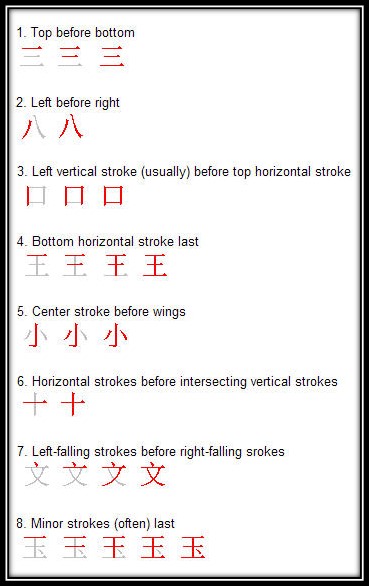
After you’ve learned all of the strokes and stroke order rules, you will now be able to write any character even if you don’t know what they mean!
Understanding Chinese radicals
Let’s move on to the Chinese radicals! The radicals can be considered as the pillar of the Chinese language learning . Each radical has its own meaning.
- “心” is a Character which represents the “heart”.
- When it acts as a radical, “心 ” can usually be seen together with the “heart-related” characters .
- Some of the examples are “想 – xiǎng (think),怒 – nù (angry),感 – gǎn (feel, sense)” which are all somewhat related to emotion, feeling, mind, thinking or thought.
- If 心 radical is written below the character ,it is called 心字底 (xīn zi dǐ, meaning 心 at the bottom)。
- If it is written on the left side , it is usually written as “忄” and we call it 竖心旁 (shù xīn páng). e.g.: 快-kuài (quick),慢- màn (slow),情- qíng (feelings, emotions).
- Some radicals are also used for their phonetic sounds.
- 青 qīng radical can be seen in a lot of Chinese characters which sound ” qīng “ . They are called phonetical radical because the words with 青 radical are pronounced in similar phonetic sound with only tonal difference .
- 请 – qǐng (to ask, to request ), 情 – qíng (feelings, emotions), 清 – qīng (clear, distinct ).
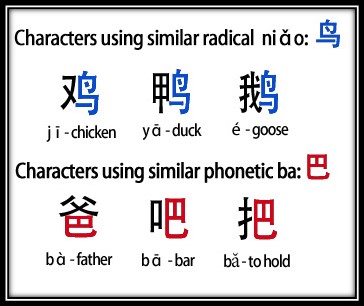
Chinese characters with similar radicals
Another interesting fact about Chinese writing is that the Chinese characters are written as pictures in the past like the Egyptians! Those characters derived from images are called “pictogram”. Many of the easy Chinese characters are pictograms! Then they slowly transformed into the systematic words we are using today.
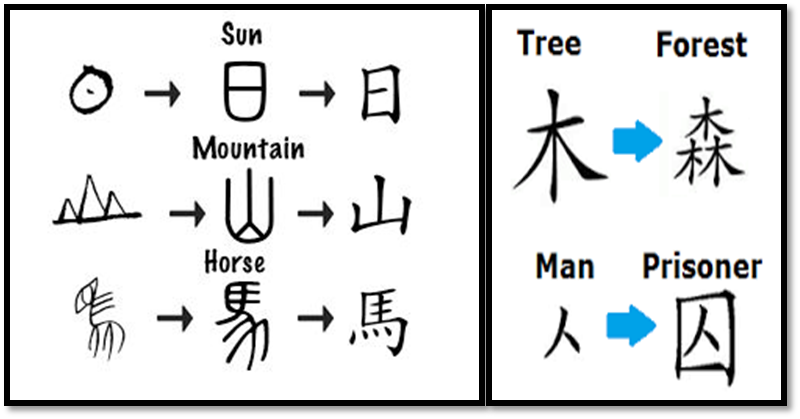
Transformation of Chinese characters
If you want to explore more simple characters, check out: 40 easy Chinese Characters
Connection between the strokes and the radicals
After you’ve learned about the strokes and the radicals, some of you might still be confused about ” how are these 2 related” ? So I’m going to explain it to you by using the example of “火 – huǒ” (fire) radical .
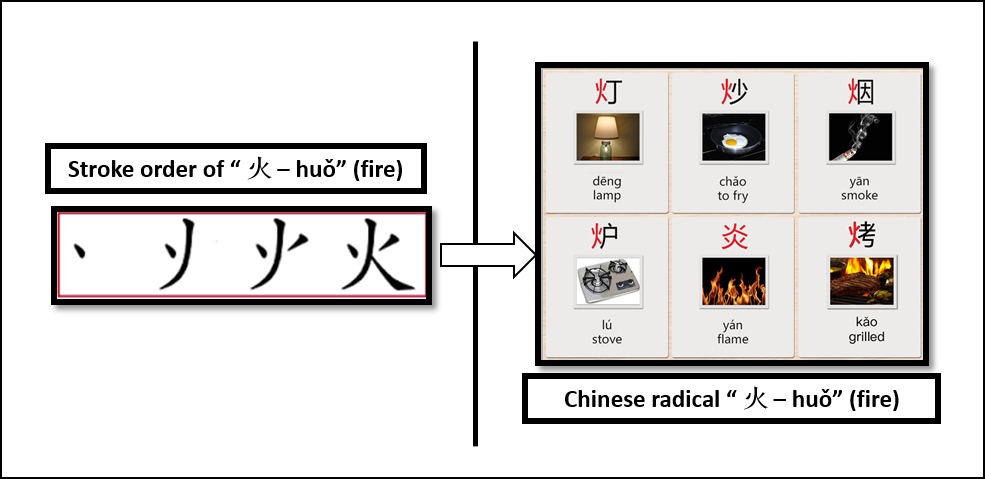
the connection between the stroke and the radical
As you can see in the picture above, “火 – huǒ” (fire) radical has 4 strokes . “火 – huǒ” ( fire ) radical is usually found together with the characters related to ‘fire’. E.g., ” 灯 – dēng” (lamp), “炒 – ” (fry ), “烟 – yān” (smoke), ” 炎 – yàn” (flame), ” 炉 – lú” (stove) and “烤 – kǎo” (roast), all of which have something to do with fire. But as I’ve mentioned earlier, sometimes radical represents the phonetic sound of the character instead of the meaning.
So in short, “the strokes let us know how to write” whereas ” the radicals give us the meaning behind each character for us to memorize more easily” .
Summary of Chinese writing
In conclusion, I would like to summarize what we have learned earlier.
- In Chinese writing, you need to learn the strokes and strokes orders first .
- Only then, you will know how to write Chinese characters in the correct way.
- After that, you also need to study the radicals and the logic behind them.
- You can also make good use of pictograms image to help you remember the characters easily.
That way, you won’t need to do rote learning ( writing the characters again and again until you remember them) for Chinese characters. I hope this blog motivates you to start Chinese writing right now!
Knowledge is good but the act of presentation is better. Why not start a free trial and start to learn mandarin today! For more learn Chinese materials, please stay tuned with us!
Related posts:

Leave a Reply Cancel reply
Your email address will not be published. Required fields are marked *
Save my name, email, and website in this browser for the next time I comment.
This site uses Akismet to reduce spam. Learn how your comment data is processed .

Improve Chinese Essay Writing- A Complete How to Guide
- Last updated: June 6, 2019
- Learn Chinese
Writing can reflect a writer’s power of thought and language organization skills. It is critical to master Chinese writing if you want to take your Chinese to the next level. How to write good Chinese essays? The following six steps will improve Chinese essay writing:
Before You Learn to Improve Chinese Essay Writing
Before you can write a good essay in Chinese, you must first be accustomed with Chinese characters. Unlike English letters, Chinese characters are hieroglyphs, and the individual strokes are different from each other. It is important to be comfortable with writing Chinese characters in order to write essays well in Chinese. Make sure to use Chinese essay writing format properly. After that, you will be ready to improve Chinese essay writing.
Increase Your Chinese Words Vocabulary
With approximately 100,000 words in the Chinese language, you will need to learn several thousand words just to know the most common words used. It is essential to learn as many Chinese words as possible if you wish to be a good writer. How can you enlarge your vocabulary? Try to accumulate words by reading daily and monthly. Memory is also very necessary for expanding vocabulary. We should form a good habit of exercising and reciting as more as we can so that to enlarge vocabulary. Remember to use what you have learned when you write in Chinese so that you will continually be progressing in your language-learning efforts.
Acquire Grammar,Sentence Patterns and Function Words
In order to hone your Chinese writing skills , you must learn the grammar and sentence patterns. Grammar involves words, phrases, and the structure of the sentences you form. There are two different categories of Chinese words: functional and lexical. Chinese phrases can be categorized as subject-predicate phrases (SP), verb-object phrases (VO), and co-ordinate phrases (CO). Regarding sentence structure, each Chinese sentence includes predicate, object, subject, and adverbial attributes. In addition, function words play an important role in Chinese semantic understanding, so try to master the Chinese conjunction, such as conjunction、Adverbs、Preposition as much as you can. If you wish to become proficient at writing in Chinese, you must study all of the aspects of grammar mentioned in this section.
Keep a Diary Regularly to Note Down Chinese Words,Chinese Letters
Another thing that will aid you in becoming a better writer is keeping a journal in Chinese. Even if you are not interested in expanding your writing skills, you will find that it is beneficial for many day-to-day tasks, such as completing work reports or composing an email. Journaling on a regular basis will help you form the habit of writing, which will make it feel less like a chore. You may enjoy expressing yourself in various ways by writing; for instance, you might write poetry in your journal. On a more practical side of things, you might prefer to simply use your journal as a way to purposely build your vocabulary .
Persistence in Reading Everyday
In addition to expanding your view of the world and yourself, reading can help you improve your writing. Reading allows you to learn by example; if you read Chinese daily, you will find that it is easier to write in Chinese because you have a greater scope of what you can do with the vocabulary that you’ve learned. Choose one favorite Chinese reading , Read it for an hour or 2,000 words or so in length each day.
Whenever you come across words or phrases in your reading that you don’t understand, take the time to check them in your dictionary and solidify your understanding of them. In your notebook, write the new word or phrase and create an example sentence using that new addition to your vocabulary. If you are unsure how to use it in a sentence, you can simply copy the sample sentence in your dictionary.
Reviewing the new vocabulary word is a good way to improve your memory of it; do this often to become familiar with these new words. The content of reading can be very broad. It can be from novels, or newspapers, and it can be about subjects like economics or psychology. Remember you should read about things you are interested in. After a certain period of accumulation by reading, you will greatly improve your Chinese writing.
Do Essay Writing Exercise on a Variety of Subjects
As the saying goes, “practice makes perfect.” In order to improve your China Essay Writing , you should engage in a variety of writing exercises. For beginners, you should start with basic topics such as your favorite hobby, future plans, favorite vacation spot, or any other topic that you can write about without difficulty.
For example :《我的一天》( Wǒ de yì tiān, my whole day’s life ),《我喜欢的食物》( Wǒ xǐhuan de shíwù, my favorite food ),《一次难忘的旅行》( yí cì nánwàng de lǚxíng, an unforgettable trip ) etc.
Generally the writing topics can be classified into these categories: a recount of an incident,a description of something/someone, a letter, formulate your own opinion on an issue based on some quote or picture etc.
Takeaway to Improve Chinese Essay Writing
Keep an excel spreadsheet of 口语(Kǒuyǔ, spoken Chinese) –书面语(Shūmiànyǔ, written Chinese) pairs and quotes of sentences that you like. You should also be marking up books and articles that you read looking for new ways of expressing ideas. Using Chinese-Chinese dictionaries is really good for learning how to describe things in Chinese.

Online Chinese Tutors
- 1:1 online tutoring
- 100% native professional tutors
- For all levels
- Flexible schedule
- More effective
- Share on Facebook
- Share on LinkedIn
- Share via Email

Qin Chen focuses on teaching Chinese and language acquisition. She is willing to introduce more about Chinese learning ways and skills. Now, she is working as Mandarin teacher at All Mandarin .
You May Also Like

This Post Has 3 Comments
When I used the service of pro essay reviews, I was expecting to have the work which is completely error free and have best quality. I asked them to show me the working samples they have and also their term and condition. They provided me the best samples and i was ready to hire them for my work then.
This is fascinating article, thank you!
Thank you so much for sharing this type of content. That’s really useful for people who want to start learning chinese language. I hope that you will continue sharing your experience.
Leave a Reply Cancel reply
Your email address will not be published. Required fields are marked *
- Skip to primary navigation
- Skip to main content
- Skip to primary sidebar
- Skip to footer
StoryLearning
Learn A Language Through Stories
How to Write in Chinese – A Beginner’s Guide
You probably think learning how to write in Chinese is impossible.
And I get it.
I’m a native English speaker, and I know how complex Chinese characters seem.
But you’re about to learn that it's not impossible .
I’ve teamed up with Kyle Balmer from Sensible Chinese to show you how you can learn the basic building blocks of the Chinese written language, and build your Chinese vocabulary quickly.
First, you’ll learn the basics of how the Chinese written language is constructed. Then, you’ll get a step-by-step guide for how to write Chinese characters sensibly and systematically .
Wondering how it can be so easy?
Then let’s get into it.
Don't have time to read this now? Click here to download a free PDF of the article
By the way, if you want to learn Chinese fast and have fun, my top recommendation is Chinese Uncovered which teaches you through StoryLearning®.
With Chinese Uncovered you’ll use my unique StoryLearning® method to learn Chinese through story… not rules.
It’s as fun as it is effective.
If you’re ready to get started, click here for a 7-day FREE trial.
How To Write In Chinese
Chinese is a complex language with many dialects and varieties.
Before we dive into learning to write Chinese characters, let’s just take a second to be clear exactly what we’ll be talking about.
First, you’ll be learning about Mandarin Chinese , the “standard” dialect. There are 5 main groups of dialects and perhaps 200 individual dialects in China & Taiwan. Mandarin Chinese is the “standard” used in Beijing and spoken or understood, by 2/3 of the population.
Second, there are two types of Chinese characters: Traditional and Simplified . In this article, we’ll be talking about Simplified Chinese characters, which are used in the majority of Mainland China.
There is an ongoing politicised debate about the two kinds of characters, and those asking themselves: “Should I learn traditional or simplified Chinese characters?” can face a difficult choice.
- For more on difference between Simplified and Traditional characters read this article
- To learn more about “the debate” read this excellent Wikipedia article
- If you want to switch Simplified characters into Traditional, you might like the fantastic New Tong Wen Tang browser plugin
First Steps in Learning Chinese Characters
When learning a European language, you have certain reference points that give you a head start.
If you're learning French and see the word l'hotel , for example, you can take a pretty good guess what it means! You have a shared alphabet and shared word roots to fall back on.
In Chinese this is not the case.
When you're just starting out, every sound, character, and word seems new and unique. Learning to read Chinese characters can feel like learning a whole set of completely illogical, unconnected “squiggles”!
The most commonly-taught method for learning to read and write these “squiggles” is rote learning .
Just write them again and again and practise until they stick in your brain and your hand remembers how to write them! This is an outdated approach, much like reciting multiplication tables until they “stick”.
I learnt this way.
Most Chinese learners learnt this way.
It's painful…and sadly discourages a lot of learners.
However, there is a better way.
Even without any common reference points between Chinese and English, the secret is to use the basic building blocks of Chinese, and use those building blocks as reference points from which to grow your knowledge of written Chinese.
This article will:
- Outline the different levels of structure inherent in Chinese characters
- Show you how to build your own reference points from scratch
- Demonstrate how to build up gradually without feeling overwhelmed
The Structure Of Written Chinese
The basic structure of written Chinese is as follows:
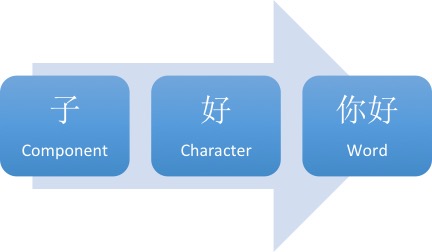
I like to think of Chinese like Lego . .. it's very “square”!
The individual bricks are the components (a.k.a radicals ).
We start to snap these components together to get something larger – the characters.
We can then snap characters together in order to make Chinese words.
Here's the really cool part about Chinese: Each of these pieces, at every level, has meaning.
The component, the character, the word… they all have meaning.
This is different to a European language, where the “pieces” used to make up words are letters.
Letters by themselves don't normally have meaning and when we start to clip letters together we are shaping a sound rather than connecting little pieces of meaning. This is a powerful difference that comes into play later when we are learning vocabulary.
Let's look at the diagram again.
Here we start with the component 子. This has the meaning of “child/infant”.
The character 好 (“good”) is the next level. Look on the right of the character and you'll see 子. We would say that 子 is a component of 好.
Now look at the full word 你好 (“Hello”). Notice that the 子 is still there.
- The character 好 is built of the components 女 and 子.
- The character 你 is built from 人 + 尔.
- The word 你好 in turn is constructed out of 你 + 好.
Here's the complete breakdown of that word in an easy-to-read diagram:
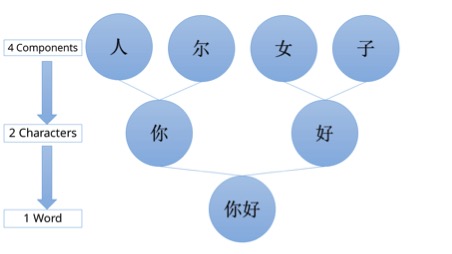
Now look at this photo of this in real life !
Don't worry if you can't understand it. Just look for some shapes that you have seen before.

The font is a little funky, so here are the typed characters: 好孩子
What components have you seen before?
Did you spot them?

This is a big deal.
Here's why…
Why Character Components Are So Important
One of the big “scare stories” around Chinese is that there are 50,000 characters to learn.
Now, this is true. But learning them isn't half as bad as you think.
Firstly, only a few thousand characters are in general everyday use so that number is a lot more manageable.
Second, and more importantly, those 50,000 characters are all made up of the same 214 components .
And you already know one of them: 子 (it's one of those 214 components).

The fact that you can now recognise the 子 in the image above is a huge step forward.
You can already recognise one of the 214 pieces all characters are made up of.
Even better is the fact that of these 214 components it's only the 50-100 most common you'll be running into again and again.
This makes Chinese characters a lot less scary.
Once you get a handle on these basic components, you'll quickly recognise all the smaller pieces and your eyes will stop glazing over!
This doesn't mean you'll necessarily know the meaning or how to pronounce the words yet (we'll get onto this shortly) but suddenly Chinese doesn't seem quite so alien any more.
Memorising The Components Of Chinese Characters
Memorising the pieces is not as important as simply realising that ALL of Chinese is constructed from these 214 pieces.
When I realised this, Chinese became a lot more manageable and I hope I've saved you some heartache by revealing this early in your learning process!
Here are some useful online resources for learning the components of Chinese characters:
- An extensive article about the 214 components of Chinese characters with a free printable PDF poster.
- Downloadable posters of all the components, characters and words.
- If you like flashcards, there's a great Anki deck here and a Memrise course here .
- Wikipedia also has a sweet sortable list here .
TAKEAWAY : Every single Chinese character is composed of just 214 “pieces”. Only 50-100 of these are commonly used. Learn these pieces first to learn how to write in Chinese quickly.
Moving From Components To Chinese Characters
Once you've got a grasp of the basic building blocks of Chinese it's time to start building some characters!
We used the character 好 (“good”) in the above example. 好 is a character composed of the components 女 (“woman”) and 子 (“child”).
Unlike the letters of the alphabet in English, these components have meaning .
(They also have pronunciation, but for the sake of simplicity we'll leave that aside for now!)
- 女 means “woman” and 子 means “child”.
- When they are put together, 女 and 子 become 好 …and the meaning is “good”.
- Therefore “woman” + “child” = “good” in Chinese 🙂
When learning how to write in Chinese characters you can take advantage of the fact that components have their own meanings.
In this case, it is relatively easy to make a mnemonic (memory aid) that links the idea of a woman with her baby as “good”.
Because Chinese is so structured, these kind of mnemonics are an incredibly powerful tool for memorisation.
Some characters, including 好, can also be easily represented graphically. ShaoLan's book Chineasy does a fantastic job of this.
Here's the image of 好 for instance – you can see the mother and child.

Visual graphics like these can really help in learning Chinese characters.
Unfortunately, only around 5% of the characters in Chinese are directly “visual” in this way. These characters tend to get the most attention because they look great when illustrated.
However, as you move beyond the concrete in the more abstract it becomes harder and harder to visually represent ideas.
Thankfully, the ancient Chinese had an ingenious solution, a solution that actually makes the language a lot more logical and simple than merely adding endless visual pictures.
Watch Me Write Chinese Characters
In the video below, which is part of a series on learning to write in Chinese , I talk about the process of actually writing out the characters. Not thousands of times like Chinese schoolchildren. But just as a way to reinforce my learning and attack learning Chinese characters from different angles.
My Chinese handwriting leaves a lot to be desired. But it's more about a process of reinforcing my language learning via muscle memory than perfecting my handwriting.
You'll also hear me discuss some related issues such as stroke order and typing in Chinese.
The Pronunciation Of Chinese Characters
The solution was the incredibly unsexy sounding… (wait for it…) “phono-semantic compound character”.
It's an awful name, so I'm going to call them “sound-meaning characters” for now!
This concept is the key to unlocking 95% of the Chinese characters.
A sound-meaning character has a component that tells us two things:
- the meaning
- a clue to how the character is pronounced
So, in simple terms:
95% of Chinese characters have a clue to the meaning of the character AND its pronunciation.
到 means “to arrive”.
This character is made of two components. On the left is 至 and on the right is 刀.
These are two of the 214 components that make up all characters. 至 means “to arrive” and 刀 means “knife”.
Any idea which one gives us the meaning? Yup – it's 至, “to arrive”! (That was an easy one 🙂 )
But how about the 刀? This is where it gets interesting.
到 is pronounced dào.
刀, “knife” is pronounced dāo.
The reason the 刀 is placed next to 至 in the character 到 is just to tell us how to pronounce the character! How cool is that?
Now, did you notice the little lines above the words: dào and dāo?
Those are the tone markers, and in this case they are both slightly different. These two characters have different tones so they are not exactly the same pronunciation.
However, the sound-meaning compound has got us 90% of the way to being able to pronounce the character, all because some awesome ancient Chinese scribe thought there should be a shortcut to help us remember the pronunciation!
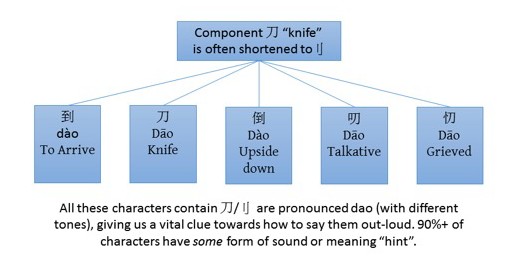
Let's look at a few more examples of how 刀 is used in different words to give you an idea of the pronunciation.
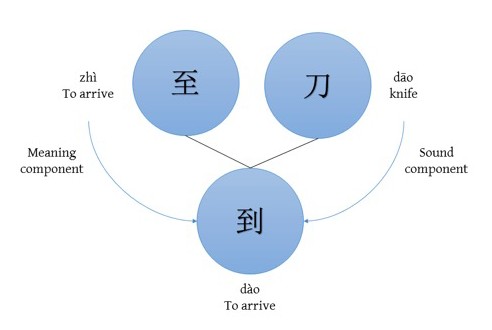
Even if sometimes:
- the sound-meaning character gives us the exact sound and meaning
- or it gets us in the ballpark
- or worse it is way off because the character has changed over the last 5,000 years!
Nevertheless, there's a clue about the pronunciation in 95% of all Chinese characters, which is a huge help for learning how to speak Chinese.
TAKEAWAY : Look at the component parts as a way to unlock the meaning and pronunciations of 95% of Chinese characters. In terms of “hacking” the language, this is the key to learning how to write in Chinese quickly.
From Chinese Characters To Chinese Words
First we went from components to characters.
Next, we are going from characters to words.
Although there are a lot of one-character words in Chinese, they tend to either be classically-rooted words like “king” and “horse” or grammatical particles and pronouns.
The vast majority of Chinese words contain two characters.
The step from characters to words is where, dare I say it, Chinese script gets easy!
Come on, you didn't think it would always be hard did you? 🙂
Unlike European languages Chinese's difficulty is very front-loaded.
When you first learn to write Chinese, you'll discover a foreign pronunciation system, a foreign tonal system and a very foreign writing system.
As an English speaker, you can normally have a good shot at pronouncing and reading words in other European languages, thanks to the shared alphabet.
Chinese, on the other hand, sucker-punches you on day one… but gets a little more gentle as you go along.
One you've realised these things:
- there aren't that many components to deal with
- all characters are made up of these basic components
- words are actually characters bolted together
…then it's a matter of just memorising a whole bunch of stuff!
That's not to say there isn't a lot of work involved, only to say that it's not particularly difficult. Time-consuming, yes. Difficult, no.
This is quite different from European languages, which start off easy, but quickly escalate in difficulty as you encounter complicated grammar, tenses, case endings, technical vocabulary and so on.
Making words from Chinese characters you already know is easy and really fun . This is where you get to start snapping the lego blocks together and build that Pirate Island!
The Logic Of Chinese Writing
Here are some wonderful examples of the simplicity and logic of Chinese using the character 车 which roughly translates as “vehicle”.
- Water + Vehicle = Waterwheel = 水 +车
- Wind + Vehicle = Windmill = 风+车
- Electric + Vehicle = Tram/Trolley = 电+车
- Fire + Vehicle = Train = 火+车
- Gas + Vehicle = Car = 汽+车
- Horse + Vehicle = Horse and cart/Trap and Pony = 马+车
- Up + Vehicle = Get into/onto a vehicle =上+车
- Down + Vehicle = Get out/off a vehicle =下+车
- Vehicle + Warehouse = Garage = 车+库
- To Stop + Vehicle = to park = 停+车
Chinese is extremely logical and consistent.
This is a set of building blocks that has evolved over 5,000 years in a relatively linear progression. And you can't exactly say the same about the English language!
Just think of the English words for the Chinese equivalences above:
Train, windmill, millwheel/waterwheel, tram/trolley, car/automobile, horse and cart/trap and pony.
Unlike Chinese where these concepts are all linked by 车 there's very little consistency in our vehicle/wheel related vocabulary, and no way to link these sets of related concepts via the word itself.
English is a diverse and rich language, but that comes with its drawbacks – a case-by-case spelling system that drives learners mad.
Chinese, on the other hand, is precise and logical, once you get over the initial “alienness”.
Making The Complex Simple
This logical way of constructing vocabulary is not limited to everyday words like “car” and “train”. It extends throughout the language.
To take an extreme example let's look at Jurassic Park .
The other day I watched Jurassic Park with my Chinese girlfriend. (OK, re -watched. It's a classic!)
Part of the fun for me (annoyance for her) was asking her the Chinese for various dinosaur species.
Take a second to look through these examples. You'll love the simplicity!
- T Rex 暴龙 = tyrant + dragon
- Tricerotops 三角恐龙 three + horn + dinosaur
- Diplodocus 梁龙 roof-beam + dragon
- Velociraptor 伶盗龙 clever + thief + dragon (or swift stealer dragon)
- Stegosaurus 剑龙 (double-edged) sword + dragon
- Dilophosaurus 双脊龙 double+spined+dragon
Don't try to memorise these characters, just appreciate the underlying logic of how the complex concepts are constructed .
(Unless, of course, you are a palaeontologist…or as the Chinese would say a Ancient + Life + Animal + Scientist!).
I couldn't spell half of these dinosaur names in English for this article. But once I knew how the construction of the Chinese word, typing in the right characters was simple.
Once you know a handful of characters, you can start to put together complete words, and knowing how to write in Chinese suddenly becomes a lot easier.
In a lot of cases you can take educated guesses at concepts and get them right by combining known characters into unknown words.
For more on this, check my series of Chinese character images that I publish on this page . They focus on Chinese words constructed from common characters, and help you understand more of the “building block” logic of Chinese.
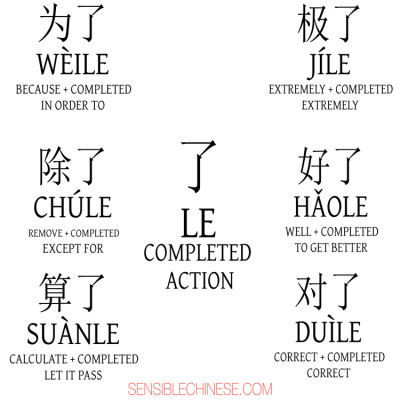
TAKEAWAY : Chinese words are constructed extremely logically from the underlying characters. This means that once you've learned a handful of characters vocabulary acquisition speeds up exponentially.
How To Learn Written Chinese Fast
Before diving into learning characters, make sure you have a decent grounding in Chinese pronunciation via the pinyin system.
The reason for this is that taking on pronunciation, tones and characters from day one is really tough.
Don't get me wrong, you can do it. Especially if you're highly motivated. But for most people there's a better way.
Learn a bit of spoken Chinese first.
With some spoken language under your belt, and an understanding of pronunciation and tones, starting to learn how to write in Chinese will seem a whole lot easier.
When you're ready, here's how to use all the information from this article and deal with written Chinese in a sensible way.
I've got a systematic approach to written Chinese which you can find in detail on Sensible Chinese .
Right now, I'm going to get you started with the basics.
The Sensible Character System
The four stages for learning Chinese characters are:
Sounds technical huh? Don't worry, it's not really.
This part of the process is about choosing what you put into your character learning system.
If you're working on the wrong material then you're wasting your efforts. Instead choose to learn Chinese characters that you are like to want to use in the future.
My list in order of priority contains:
- daily life: characters/words I've encountered through daily life
- textbooks: characters/words I've learnt from textbooks
- frequency lists: characters/words I've found in frequency lists of the most common characters and words
2. Processing
This is the “learning” part of the system.
You take a new word or character and break it down into its component parts. You can then use these components to create memory aids.
Hanzicraft.com or Pleco's built-in character decomposition tool are fantastic for breaking down new characters. These will be helpful until you learn to recognise the character components by sight. These tools will also show you if there are sound-meaning component clues in the character.
Use the individual components of a character to build a “story” around the character. Personal, sexy and violent stories tend to stick in the mind best! 🙂 I also like to add colours into my stories to represent the tones (1st tone Green, 2nd tone Blue etc.)
After the “input” and the “process”… it's time to review it all!
The simplest review system is paper flashcards which you periodically use to refresh your memory.
A more efficient method can be found in software or apps that use a Spaced Repetition System, like Anki or Pleco .
An important point: Review is not learning .
It's tempting to rely on software like Anki to drill in the vocabulary through brute-force repetition. But don't skip the first two parts – processing the character and creating a mnemonic are key parts of the process.
It isn't enough to just learn and review your words… you also need to put them into use !
Thankfully, technology has made this easier than ever. Finding a language exchange partner or a lesson with a cost-effective teacher is super simple nowadays, so there's no excuse for not putting your new vocabulary into action!
The resources I personally use are:
- Spoken – iTalki
- Written – Lang-8
- Short form written – WeChat / HelloTalk
Importantly, whilst you are using your current vocabulary in these forms of communication, you'll be picking up new content all the time, which you can add back into your system.
The four steps above are a cycle that you will continue to rotate through – all the corrections and new words you receive during usage should become material to add to the system.
To recap, the four steps of systematically learning Chinese characters are:
By building these steps into your regular study schedule you can steadily work through the thousands of Chinese characters and words you'll need to achieve literacy.
This is a long-haul process! So having a basic system in place is very important for consistency.
You can find out a lot more about The Sensible Chinese Character Learning System and how to write in Chinese here .
Top Chinese Learning Links And Resources
- Chinese Language Learning Resource List – a curated list of tools and content available online and in print to help your Chinese learning, all categorised by usage type.
- Sensible Character Learning System – the full system outlined in a series of blog articles for those who want more detail and tips on how to refine their character learning.
- 111 Mandarin Chinese resources you wish you knew – Olly’s huge list of the best resources on the web for learning Chinese
I hope you enjoyed this epic guide to learning how to write in Chinese!
Please share this post with any friends who are learning Chinese, then leave us a comment below!
Language Courses
- Language Blog
- Testimonials
- Meet Our Team
- Media & Press
Download this article as a FREE PDF ?
What is your current level in Swedish?
Perfect! You’ve now got access to my most effective [level] Swedish tips…
Where shall I send the tips and your PDF?
We will protect your data in accordance with our data policy.
What is your current level in Danish?
Perfect! You’ve now got access to my most effective [level] Danish tips…
NOT INTERESTED?
What can we do better? If I could make something to help you right now, w hat would it be?
Which language are you learning?
What is your current level in [language] ?
Perfect! You’ve now got access to my most effective [level] [language] tips, PLUS your free StoryLearning Kit…
Where shall I send them?
Download this article as a FREE PDF?
Great! Where shall I send my best online teaching tips and your PDF?
Download this article as a FREE PDF ?
What is your current level in Arabic?
Perfect! You’ve now got access to my most effective [level] Arabic tips…
FREE StoryLearning Kit!
Join my email newsletter and get FREE access to your StoryLearning Kit — discover how to learn languages through the power of story!
Download a FREE Story in Japanese!
Enter your email address below to get a FREE short story in Japanese and start learning Japanese quickly and naturally with my StoryLearning® method!
What is your current level in Japanese?
Perfect! You’ve now got access to the Japanese StoryLearning® Pack …
Where shall I send your download link?
Download Your FREE Natural Japanese Grammar Pack
Enter your email address below to get free access to my Natural Japanese Grammar Pack and learn to internalise Japanese grammar quickly and naturally through stories.
Perfect! You’ve now got access to the Natural Japanese Grammar Pack …
What is your current level in Portuguese?
Perfect! You’ve now got access to the Natural Portuguese Grammar Pack …
What is your current level in German?
Perfect! You’ve now got access to the Natural German Grammar Pack …
Train as an Online Language Teacher and Earn from Home
The next cohort of my Certificate of Online Language Teaching will open soon. Join the waiting list, and we’ll notify you as soon as enrolment is open!
Perfect! You’ve now got access to my most effective [level] Portuguese tips…
What is your current level in Turkish?
Perfect! You’ve now got access to my most effective [level] Turkish tips…
What is your current level in French?
Perfect! You’ve now got access to the French Vocab Power Pack …
What is your current level in Italian?
Perfect! You’ve now got access to the Italian Vocab Power Pack …
Perfect! You’ve now got access to the German Vocab Power Pack …
Perfect! You’ve now got access to the Japanese Vocab Power Pack …
Download Your FREE Japanese Vocab Power Pack
Enter your email address below to get free access to my Japanese Vocab Power Pack and learn essential Japanese words and phrases quickly and naturally. (ALL levels!)
Download Your FREE German Vocab Power Pack

Enter your email address below to get free access to my German Vocab Power Pack and learn essential German words and phrases quickly and naturally. (ALL levels!)
Download Your FREE Italian Vocab Power Pack
Enter your email address below to get free access to my Italian Vocab Power Pack and learn essential Italian words and phrases quickly and naturally. (ALL levels!)
Download Your FREE French Vocab Power Pack
Enter your email address below to get free access to my French Vocab Power Pack and learn essential French words and phrases quickly and naturally. (ALL levels!)
Perfect! You’ve now got access to the Portuguese StoryLearning® Pack …
What is your current level in Russian?
Perfect! You’ve now got access to the Natural Russian Grammar Pack …
Perfect! You’ve now got access to the Russian StoryLearning® Pack …
Perfect! You’ve now got access to the Italian StoryLearning® Pack …
Perfect! You’ve now got access to the Natural Italian Grammar Pack …
Perfect! You’ve now got access to the French StoryLearning® Pack …
Perfect! You’ve now got access to the Natural French Grammar Pack …
What is your current level in Spanish?
Perfect! You’ve now got access to the Spanish Vocab Power Pack …
Perfect! You’ve now got access to the Natural Spanish Grammar Pack …
Perfect! You’ve now got access to the Spanish StoryLearning® Pack …
Where shall I send them?
What is your current level in Korean?
Perfect! You’ve now got access to my most effective [level] Korean tips…
Perfect! You’ve now got access to my most effective [level] Russian tips…
Perfect! You’ve now got access to my most effective [level] Japanese tips…
What is your current level in Chinese?
Perfect! You’ve now got access to my most effective [level] Chinese tips…
Perfect! You’ve now got access to my most effective [level] Spanish tips…
Perfect! You’ve now got access to my most effective [level] Italian tips…
Perfect! You’ve now got access to my most effective [level] French tips…
Perfect! You’ve now got access to my most effective [level] German tips…
Download Your FREE Natural Portuguese Grammar Pack
Enter your email address below to get free access to my Natural Portuguese Grammar Pack and learn to internalise Portuguese grammar quickly and naturally through stories.
Download Your FREE Natural Russian Grammar Pack
Enter your email address below to get free access to my Natural Russian Grammar Pack and learn to internalise Russian grammar quickly and naturally through stories.
Download Your FREE Natural German Grammar Pack
Enter your email address below to get free access to my Natural German Grammar Pack and learn to internalise German grammar quickly and naturally through stories.
Download Your FREE Natural French Grammar Pack
Enter your email address below to get free access to my Natural French Grammar Pack and learn to internalise French grammar quickly and naturally through stories.
Download Your FREE Natural Italian Grammar Pack
Enter your email address below to get free access to my Natural Italian Grammar Pack and learn to internalise Italian grammar quickly and naturally through stories.
Download a FREE Story in Portuguese!

Enter your email address below to get a FREE short story in Brazilian Portuguese and start learning Portuguese quickly and naturally with my StoryLearning® method!
Download a FREE Story in Russian!
Enter your email address below to get a FREE short story in Russian and start learning Russian quickly and naturally with my StoryLearning® method!
Download a FREE Story in German!
Enter your email address below to get a FREE short story in German and start learning German quickly and naturally with my StoryLearning® method!
Perfect! You’ve now got access to the German StoryLearning® Pack …
Download a FREE Story in Italian!
Enter your email address below to get a FREE short story in Italian and start learning Italian quickly and naturally with my StoryLearning® method!
Download a FREE Story in French!

Enter your email address below to get a FREE short story in French and start learning French quickly and naturally with my StoryLearning® method!
Download a FREE Story in Spanish!
Enter your email address below to get a FREE short story in Spanish and start learning Spanish quickly and naturally with my StoryLearning® method!
FREE Download:
The rules of language learning.

Enter your email address below to get free access to my Rules of Language Learning and discover 25 “rules” to learn a new language quickly and naturally through stories.
What can we do better ? If I could make something to help you right now, w hat would it be?
What is your current level in [language]?
Perfect! You’ve now got access to my most effective [level] [language] tips…
Download Your FREE Spanish Vocab Power Pack

Enter your email address below to get free access to my Spanish Vocab Power Pack and learn essential Spanish words and phrases quickly and naturally. (ALL levels!)
Download Your FREE Natural Spanish Grammar Pack
Enter your email address below to get free access to my Natural Spanish Grammar Pack and learn to internalise Spanish grammar quickly and naturally through stories.
Free Step-By-Step Guide:
How to generate a full-time income from home with your English… even with ZERO previous teaching experience.
What is your current level in Thai?
Perfect! You’ve now got access to my most effective [level] Thai tips…
What is your current level in Cantonese?
Perfect! You’ve now got access to my most effective [level] Cantonese tips…
Steal My Method?
I’ve written some simple emails explaining the techniques I’ve used to learn 8 languages…
I want to be skipped!
I’m the lead capture, man!
Join 84,574 other language learners getting StoryLearning tips by email…
“After I started to use your ideas, I learn better, for longer, with more passion. Thanks for the life-change!” – Dallas Nesbit
Perfect! You’ve now got access to my most effective [level] [language] tips…
Perfect! You’ve now got access to my most effective [level] [language] tips…
Join 122,238 other language learners getting StoryLearning tips by email…
Find the perfect language course for you.
Looking for world-class training material to help you make a breakthrough in your language learning?
Click ‘start now’ and complete this short survey to find the perfect course for you!
Do you like the idea of learning through story?
Do you want…?

How to Write a Chinese Essay
Dec 16, 2020 | Guest Blogs & Media
The more essays you write, the better you get at communicating with Chinese. To write a good essay, you first have to reach a high language mastery level.
Do you admire the students who write seamless Chinese essay? If you do, then you should know that you too can achieve this level of proficiency. In the meantime, don’t be afraid to pay for your essay if you cannot write it on your own. Online academic writers are a resource each student should take advantage of.
Here are tips to help you get better at writing essays in Chinese.

Learn New Chinese Words
The key to communicating in a new language is learning as many words as you can. Take it upon yourself to learn at least one Chinese word a day. Chinese words are to essay writing what bricks are to a building. The more words you have, the better you get at constructing meaningful sentences.
Case in point, if you’re going to write a Chinese sentence that constitutes ten words, but you don’t know the right way to spell three of those words, your sentence might end up not making sense.
During your Chinese learning experience, words are your arsenal and don’t forget to master the meaning of each word you learn.
Read Chinese Literature
Reading is the most effective way of learning a new language. Remember not to read for the sake of it; find out the meaning of each new word you encounter. When you are an avid reader of Chinese literature, nothing can stop you from writing fluent Chinese.
In the beginning, it might seem like you’re not making any progress, but after a while, you will notice how drastically your writing will change. Receiving information in Chinese helps your brain get accustomed to the language’s sentence patterns, and you can translate this to your essays.
Be extensive in your reading to ensure you get as much as possible out of each article. Remember that it’s not about how fast you finish an article, but rather, how much you gain from the exercise.
Translate Articles from your Native Language to Chinese
Have you ever thought about translating your favorite read to Chinese? This exercise might be tedious, but you will learn a lot from it. The art of translation allows you to seamlessly shift from one language’s sentence pattern into the other. The more you do this, the easier it will be for your brain to convert English sentences into Chinese phrases that people can comprehend.
You can always show your Chinese professor your translations for positive criticism. The more you get corrected, the better you will get at translation. Who knows, you might actually like being a translator once you graduate.
Final Thoughts

by Adrian Lomezzo
Adrian Lomezzo is a freelance writer. Firstly, he has been developing as a content manager and working with different websites, and the main goal of his was to develop the content making it in the first place. Secondly, Adrian had a big desire to help students and adults in self-development in this field and teach them to improve their skills. As a lover of traveling, he did not want to be in one place, and became a writer who could be closer to everyone, and share precious information from the corners of the world.
Submit a Comment Cancel reply
Your email address will not be published. Required fields are marked *
Submit Comment
Other posts you might like

Congratulations That’s Mandarin Winter 2022 Graduates
Mar 31, 2022 | Beijing , News
We’re so excited and proud to see our students achieve goals and improve their Chinese skills at That’s Mandarin. We know how hardworking and diligent you are and we are happy to go through this incredible and at times difficult process of learning Chinese together...

News: NihaoKids Website Is Live!
Mar 3, 2022 | News , Online
A modern place for your children to learn Mandarin Chinese.

Mahjong Night Recap (Feb 23)
Feb 24, 2022 | Beijing , News , Shanghai
The best moments of Mahjong Night!
Get 2-week FREE Chinese Classes
Original Price: ¥ 600


Grammar , Vocabulary
Useful Chinese Essay Phrases
July 8, 2020
By Ellen

Nowadays, many international students have decided to study abroad, and China has become a highly popular destination. In universities, essay writing is a basic skill and the “Academic Writing” lectures are always attracting many students to attend.
Here we have summarized some “all-purpose” phrases and sentences which hopefully you would find useful.
Chinese Essay Phrases Used in Abstracts
The abstract should explain the purpose, method, results, and conclusion of your research, also highlighting the new ideas that you proposed; and do remember to keep your language concise while writing. The purpose of the abstract is to conclude and summarize the main contents of your essay so that the reader could have a brief understanding without having to read the entire paper. Chinese abstracts are usually around 200 characters.
Research Background, Significance, and Current Situation
Extremely useful/badly needed/affecting people’s lives (1-2 sentences)
Proposing the Object of Study
Played a very important role (1-2 sentences)
Purpose of the Study or Study Aim
The role of A in B, perhaps remains to be seen (1 sentence)
Research Methods and Results
Through what means/technique/experiment we achieved what result (several sentences)
Research Results
The phenomenon of A in B, shows what the function of B is, theoretical and applied value (1-2 sentences)

via Pixabay
Chinese Essay Phrases: Main Body
The main body includes the introduction and the main text. The introduction section could use similar phrases that we have just listed, focusing on research objects and purposes. The main text should include research methods, research results, and discussion. Writers should keep their sentences to the point and avoid rambling, also avoid using too much subjective perspective discourses, which shouldn’t be used as arguments as well.
Theoretical Basis, Approaches, and Methods
To express opinions, to emphasis, transitional expressions, chinese essay phrases: conclusion.
At the ending section of the paper, the writer should provide an objective summary, list out the future research objectives and directions, and perhaps look into the future. Keep optimistic even if your experiment results were negative.
Research Impact and Value
There you go. We hope this article helps you write amazing essays. Best of luck!
Ellen is a language specialist from China. She grew up in the US and received a master’s degree from the St Andrews University of UK. The multicultural experiences attributes to her understanding of the differences and similarities between the English and Chinese language. She currently works as an editor specialized in Language learning books.
related posts:
Must-Try Authentic Chinese Dishes
15 must-watch chinese movies for language learners, best chinese music playlists on spotify, get in touch.
- Be a Member
- English French Chinese
- General Chinese learning tips
How to Write a Good Chinese Essay
Posted by Lilian Li 17816
For any kind of language, the essay is the most difficult thing to do in the exam. Generally speaking, writing articles is just to tell a story, after you make the story clear, the article also is finished. But it also different with speaking. A good article is like a art, is worth for people to appreciate, to taste. But how to accomplish such a good art? I think the most important thing is the three points: attitude, subject matter, emotional.
A good beginning is half done. For writing, material selection and design are not the start. The most important thing still is to adjust their mentality as well. When you decided to write, then dedicated yourself to write, not half-hearted, and your thinking nature won't be upset. Once the train of thought was interrupted, your speed will be slow and the point will be word count. So how can you write down a interesting article with a good quality? All in all, attitude is can decide the success or failure of the articles.
Subject is the biggest problem in our writing. It is from life, but not all people can observe life, experience life. The only point is to write the true things, maybe not so tortuous plots, but can write a really life. Moreover, when you get the subject, there are some tips for students to pay attention:
1. Make the topic request clear: The article should around the topic, pay attention to the demand of genre and number of words, some restrictive conditions and avoid distracting, digression.
2. Determine the center, choose the right material. To conform to the fact that a typical, novel, so it’s easy to attract the attention of people.
3. Make a good outline, determine the general, write enough words.
4. Sentence writing smooth, there is no wrong character, no wrong grammar in article.
Emotion, it is very important. If we compared an article to be a human. So emotion is his soul. Man is not vegetation, when they meet something, there must be personal thoughts and feelings. Sometimes it also tend to have their own original ideas. If you can put your own thoughts, feelings and insights into the article, then this article will be very individual.
Chinese essay is not just meaning some simple Chinese characters and make a simple sentences, it needs the Chinese grammar and sentence structure, if you don't familiar with Chinese grammar, you can learn our Chinese grammar course .
At last, adhere to write diary at ordinary times, it can practicing writing. Try to read some good articles, good words and good paragraphs with a good beginning and end. Learn to accumulate and draw lessons from them.
If you are interested in our Chinese grammar course, you can try our one online free trial , you will enjoy it.
About The Author
Related articles.

Free Trial

Self-test

Concat Us

Chat online

Share Us
Want to receive regular Chinese language tips & trivia?
Hacking Chinese
A better way of learning mandarin, 20 tips and tricks to improve your chinese writing ability.

Image from The Simpsons S13E4: A Hunka Hunka Burns in Love.
Writing is an important part of learning Chinese. The written word allows us to communicate online, record our thoughts and opinions and share them with others.
Writing is also an important part of many professional applications of learning Chinese, such as communication with colleagues, partners or clients. Finally, writing is also a part of many proficiency tests.
Writing in Chinese is different compared with most other languages in that there is a dual challenge learning both to write characters and to compose text. These are two completely different skills.
In this article, I will focus on composing text. For more about learning to write characters, please read this article: My best advice on how to learn Chinese characters .
My best advice on how to learn Chinese characters
Writing as a process rather than a product
Many students and teachers treat writing as a product, putting emphasis on the text itself. This effect is often enhanced by setting a grade on a writing assignment and then moving on to the next unit.
Writing is better viewed as a process, where what you write is just a milestone on your journey towards better writing ability. This usually means that you write fewer texts, but that you work more with each one. The goal is learning, after all, not writing a certain number of characters.
It should come as no surprise that I like writing; I have spent many thousands of hours writing in a foreign language (a lot of English, much Chinese and almost no French). Naturally, this website is in English, but isn’t called “Hacking English”, so I will focus on Chinese here. I have actually published a few articles in Chinese here as well, this one about using adventure text games being the most recent one . The advice in this article is based on my own experience with writing in foreign languages, as well as reading and research into second language writing.
I have divided the writing process into three phases:
- Before writing
- During writing
- After writing
How to improve your Chinese writing ability: Before writing
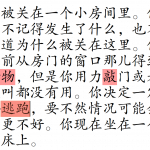
- Familiarise yourself with text type and genre – When reading, pay attention to the genre and how it works, A formal email, a shopping list and a doctoral dissertation are very different types of texts. A few questions to ask yourself are: What function does the text serve? Are there any formal characteristics of this type of text in Chinese? How is information organised in this type of text? The answers can be different in Chinese compared with your native language. For example, writing emails is very different in different languages when it comes to how to start, end and so on. Sometimes you can find information about this online as well, so it can be worth studying a bit. I actually asked a question about this on Stack Exchange back in 2012.
- Write about topics you care about – When choosing what to write, the most important consideration is what you want to communicate to others. Writing requires concentration and effort, which is harder to muster if you feel the task is boring or meaningless. We all like different things, so it’s hard to give general advice, but topics related to your own life, your experiences and opinions are good places to start. A journal or diary is great because it provides a never-ending sequence of events to write about! If you find it hard to come up with topics, here are some suggestions: 50 Questions That Will Free Your Mind , 49 ESL Writing Topics , the Book of Questions .
- Keep it on the write level – While you should write about things you care about, keep it realistic. As a rule of thumb, do not try to write about things you are not already reading about with some confidence and fluency. Don’t write about spaceflight if you’re not already comfortable reading about it in Chinese; stay away from writing fiction heavy on descriptions of places and events if you’re not reading such stories a already. I’ve done my fair share of writing beyond my level and it’s not worth it. You will spend many times longer on each text, but you don’t learn more. As I said before, writing is the result of learning, not the cause of it.
How to improve your Chinese writing ability: During writing
- Organise your thoughts by writing a simple outline – When it comes to writing clearly, much of the thought-process is the same no matter what language you’re writing in. It’s hard to write coherent and easy-to-read text even in your native language if you yourself only figure out what you want to say as you go along. Needless to say, it’s even harder in a foreign language! Write a simple outline before you start. This can be a handful of bullet points.
- Write a full draft, then polish – Inexperienced writers often get stuck in details immediately. What should the title be? How should it be worded? Does A make a better title than B? These things will emerge later. Instead of focusing on details from the start, write a draft first. This version is probably quite bad, relatively speaking, but fortunately, you don’t need to show this to anyone! Once you have a draft, you can go through the text again and take care of those details you skipped earlier. Choosing a title is easier after you have a draft, for example. Now that you know what the whole text is like in general, it will be much easier to work with and you also don’t feel stupid after spending one hour and having only written two sentences.

- Don’t make your text more complicated than you have to – Some students (including my past self) try to write more advanced Chinese than they can handle, thinking that throwing in more advanced words will impress people ( chengyu is a good example of this ). This almost never works and is generally a bad idea. Your goal should be to use to write as clearly as possible, using language you already know. This is also what the receiver will care about. Even on a proficiency exam, using difficult words just for the sake of it will not raise your score, especially if you use them incorrectly. Advanced readers are also very sensitive to uneven writing, so if your level is at the lower-intermediate, occasionally throwing in very hard words will just show that you used a dictionary and don’t really know what you’re doing. Teachers of all languages can testify to how easy it is to see through this, even if students (especially kids) are baffled by how easy the teacher can tell.

- Use double translation if you want to be sure you’ve found the right word – This is when you look up a word in Chinese, then feed the result back to the dictionary and translate back to your native language. If the result seems reasonable, it’s probably the word you’re looking for. Let’s say you want to translate “beam”, as in “beam of light”. You look it up and get 横梁. You put it in your text and causes great confusion, some amusement and a bit of frustration for your Chinese teacher. If you had translated it back to English, you would have seen that 横梁 means “beam; transom; crossgirder; girder” .

How to improve your Chinese writing ability: After writing

Towards better writing ability in Chinese
This article contains tips and tricks I have collected over my 20+ years of writing in a foreign language. These are insights I wish I would have come to earlier, but that I hope will help you on your quest for better writing ability in Chinese.
This is also the advice that I give to students in the university courses I teach that focus on writing, all collected in one place with easy references to further reading. I realise that there’s more here than most of you probably bargained for, but as should be clear by now, I not only love to write, I also love writing about writing!
What’s your best tips for writing in a foreign language? Do you have any other tips beyond what I mention here? What advice would you offer other people who have just started writing in Chinese? Leave a comment below!
Editor’s note: This article was written in February 2021 and replaces several old articles with partially overlapping content. Comments from these other articles have been moved here.

12 comments
I can have great joy writing in whatever language. The issue is normally to sit down and do it.
I agree that it’s best to write about what you care about, but have once fallen in the trap of writing about something that I cared about too much for an English exam. The structure of my story came apart from wanting to but too much into the article.
If you want to say a lot about a certain topic but can’t due your level of the language, it can be frustrating.
I’m currently on a roll with my Lang-8 entries about San Francisco/California botany. It’s very easy to get specific (I can talk about one species of plant per entry), and some people seem to be interested in the topic, especially since it’s very easy for me to add personal touches (for example, when I talked about lupines, I uploaded some photos my father took of the lupines growing in my family’s backyard). I could make many, many entries about this topic (for example, I might make a follow-up entry about the lupines explaining WHY they are in the backyard).
Sounds great! Seems like an inexhaustible source of topics. I was on a roll with more than one entry per day for a while, but then… I stopped. I’ve been doing other things, but writing sentences now and then should be possible.
- Pingback: Whizz Learning | Start reading and writing Chinese as quickly and painlessly as possible!
If you asked me what is one of the tedious and frustrating things about Chinese, I would say it’s how some words (but not all) can act as verbs, adjectives AND nouns, and how any given dictionary would fail to mention this or give examples of its different uses.
Take the word 轰动 for example.
My ABC dictionary says it’s an adjective (stative verb) but then goes on to define it as: “cause a sensation; make a stir”.
My PlC dictionary gives these two examples: 轰动全国 — cause a sensation throughout the country 全场轰动 — make a stir in the audience (or in the hall) Hmm…I wonder why the position of 轰动 is switched in both of these very similar constructions?
CC dictionary says it means “to cause a sensation”.
Finally, my ADS dictionary, says it’s a Noun and means “sensation”.
Now, accepting for a moment that 轰动 can be all three (verb, adjective, and noun), why doesn’t each dictionary state this simple fact?
–Daniel
Chinese, like English, often allows the grammatical identify to be defined by context. And in other cases, we add a suffix to mark a change in grammatical function.
In English, nouns, verbs, adjectives, and adverbs do use suffices to migrate a root word and in some cases to clarify role (which seems to originate from Latin).
A noun such as ‘work’ is also the verb ‘work’, whereas ‘working’ or ‘worked’ can be adjectives. And a verb such as ‘do’ can become a noun infinite ‘to do’ or noun gerund ‘doing’
All those suffix shifts are extremely difficult to the Chinese learner of English. Being able to not bother with them may actually be an eventual blessing.
There are words in Chinese that tend to be strictly one function — mostly conjunctions and prepositions.
I heartily agree with all of these tips (even as I admit that I sometimes stray from them myself out of frustration or because I’m pressed for time).
I try to cultivate curiosity about connotations and Chinese vocabulary, and let myself get sucked into Wikipedia, so that I can get myself into good habits. I find Wikipedia an excellent source both for the types of words which are often not in dictionaries, examples of words being used in context, and more detailed explainations of a word than most dictionaries provide.
It’s also exciting on the rare occasion I find a Chinese word/phrase/chengyu which describes exactly what the original writer expresses in English, but more concisely and elegantly.
Regarding #4, I tend to do a lot of double translation to verify both meaning and usage. Relying solely on translation from Chinese to English without verification by going from English to Chinese can lead to technically correct translation that is still a bit odd.
In any event, the need to spend so much time with dictionaries can be a bit tedious and daunting, and a struggle at first. But it is well worth it.
Feels a bit weird to respond to your comment six years later, but I have now updated the article and included double translation as well! It’s something I often recommend students doing and I should of course have mentioned it in the old article as well. Thanks for reminding me about it, even if it took me many years to actually do something about it! 🙂
- Pingback: 12 topics to kickstart your Vietnamese writing - More Vietnamese
Olle, how do you feel about intermediate/advanced learners writing their outlines or drafts in their native language and then moving to Chinese? Is there research that suggests when this is/isn’t helpful, or when it might be time to move on from this habit, and how?
I doubt there is direct research that can conclusively answer this question, but I see no problem with writing an outline in one’s native language. We’re talking about few words that aren’t going to influence sentence structure or word choice once you get down to actually writing the text. If it’s easier to arrive at a clear structure by doing so in your native language, then do that!
Leave a comment Cancel reply
Your email address will not be published. Required fields are marked *
This site uses Akismet to reduce spam. Learn how your comment data is processed .
Privacy Overview

The Guide to Writing Your First Mandarin Essay
When you want to be able to make writing your first Mandarin essay nice and easy, it pays to put plenty of thought and effort into the preparation. As the old saying goes ‘fail to prepare, prepare to fail.’ To give you plenty of food for thought we’ve put together everything you need to know to get things moving. All you need to do is work through the following steps, and you’ll be submitting your essay in no time at all.
Check you understand the basics
There are so many things you have to think about when writing an essay, particularly when it’s not in your native language. But as with any cognitively demanding task, the process for getting started is always the same. Check you understand the following basics and you’ll be heading in the right direction:
- Do you know what the question means?
- Have you made a note of the final submission date?
- Make sure you read some past examples to get a feel for what’s expected of you
- Do you understand the question that has been set?
- Do you know who you can talk to if you need advice along the way?
- Are there any restrictions on the dialect you should be aware of?
Once you can write the answers to the above down on a single side of the paper, you are ready to tackle the main part of the problem: putting pen to paper.
Set aside time to write
The chances are that you’re not going to be able to pen the entire essay in a single sitting, and that’s okay. It’s nothing to be ashamed of or to worry about, and it’s natural that you need to work across multiple days when writing your first essay.
If you want to be able to make great progress, the most important thing is sticking to a routine. You need to have consistency in your application, and you need to be able to know when you are at your most productive. It’s no good staying up late one night and then carrying on early the next morning. You’d be far better off writing for the same amount of time but on two successive afternoons. Think about how your studies fit in with the rest of your daily life, and then choose the time that seems most appropriate. If you box it off and decide it’s only for writing, you’ll be in a great routine before you even know it.
Clear space so you can focus
As well as having time to write each day, you need a place to write too. The world is full of distractions (most of them are digital and social) so that means you’re going to want to keep yourself to yourself, and your phone in a different room. It might seem a little boring or uncomfortable at first, but you need to practice the habit of deep work. It’s what will allow you to create the most in the shortest time — ideal if you want to have plenty of time leftover to spend doing the other things that matter to you.
Have a daily word count in mind
Telling yourself that you want to write an essay today is one thing, but if you’re really going to push yourself to stick to your goal then you need to get quantitative. If you have a word count in mind that you need to hit, then it will prevent you from giving up and throwing in the towel the minute you start having to think and concentrate more than feels normal. Just like working out in the gym, it’s the temporary moments of extra effort that really drive the big differences. It’s when you’ll see the biggest improvement in your writing ability, and the lessons you teach yourself will stay with you for years to come. Ideal if you want to become a fluent Mandarin writer, as well as an engaging face-to-face speaker.
Read widely to provide context
When you’re immersed in an essay it can be all too easy to become blinkered and fail to pay attention to everything else that’s going on around you. Of course, you want to be focused on the task at hand, but you don’t want to be single-minded to the point of ignoring other great learning resources that are just a click away.
Reading widely is one of the best ways to improve your essay writing because it exposes you to techniques and approaches used by the best of the best. You’re not expected to be able to instantly write like a native speaker after an hour of reading. But what you will be able to do with consistent application is build up confidence and familiarity with written Mandarin. Over time this will reflect on the quality and depth of your writing as you gradually improve and take onboard lessons you’ve learned.
Take a break before you proofread
Last but not least, you need to remember that essay writing is a marathon, not a sprint. It’s all about taking the time to get things written before you hand them in, not racing through to try and finish on time. If you want to get the most out of your writing you need to take a day off between finishing your draft and proofing it. That way your brain will have had plenty of time to reflect on the work you’ve produced, and you’ll be able to spot many more little mistakes and places for improvement than you would if you proofed right away.
Final Thoughts
Writing Mandarin is a challenging task that will test your language skills and make you think hard about how to apply what you’ve learned so far. It might be slow going to begin with, but that’s great as it means you’re pushing your limits and building on your existing skills. If you want to be able to master Mandarin, you need to persevere and stay the course. Once you do, you’ll start to improve a lot faster than you expect.
By Diana Adjadj | A Super Chineasian
You may also like

Learn 10 Simple Chinese Dessert Words with Pictures & Sounds

Understanding the Three Philosophical Leaders Of The East

Chinese Tea, English Tea or Matcha? Learn Them All in Chinese!
Tell your chineasy stories.

Subscribe to our Newsletter
Copyright © 2024 Chineasy. All rights reserved.

How to Write a Chinese Essay
by That's Mandarin | Dec 16, 2020

As a Chinese student, learning how to write an essay in this language is very important. After all, how else are you going to express yourself? Writing is one of the ways professors use to teach this language because writing helps with the retention of information.
The more essays you write, the better you get at communicating with Chinese. To write a good essay, you first have to reach a high language mastery level.
Do you admire the students who write seamless Chinese essay? If you do, then you should know that you too can achieve this level of proficiency. In the meantime, don’t be afraid to pay for your essay if you cannot write it on your own. Online academic writers are a resource each student should take advantage of.
Here are tips to help you get better at writing essays in Chinese.

Learn New Chinese Words
The key to communicating in a new language is learning as many words as you can. Take it upon yourself to learn at least one Chinese word a day. Chinese words are to essay writing what bricks are to a building. The more words you have, the better you get at constructing meaningful sentences.
Case in point, if you’re going to write a Chinese sentence that constitutes ten words, but you don’t know the right way to spell three of those words, your sentence might end up not making sense.
During your Chinese learning experience, words are your arsenal and don’t forget to master the meaning of each word you learn.
Read Chinese Literature
Reading is the most effective way of learning a new language. Remember not to read for the sake of it; find out the meaning of each new word you encounter. When you are an avid reader of Chinese literature, nothing can stop you from writing fluent Chinese.
In the beginning, it might seem like you’re not making any progress, but after a while, you will notice how drastically your writing will change. Receiving information in Chinese helps your brain get accustomed to the language’s sentence patterns, and you can translate this to your essays.
Be extensive in your reading to ensure you get as much as possible out of each article. Remember that it’s not about how fast you finish an article, but rather, how much you gain from the exercise.
Translate Articles from your Native Language to Chinese
Have you ever thought about translating your favorite read to Chinese? This exercise might be tedious, but you will learn a lot from it. The art of translation allows you to seamlessly shift from one language’s sentence pattern into the other. The more you do this, the easier it will be for your brain to convert English sentences into Chinese phrases that people can comprehend.
You can always show your Chinese professor your translations for positive criticism. The more you get corrected, the better you will get at translation. Who knows, you might actually like being a translator once you graduate.
Final Thoughts
Writing in Chinese is as foreign as writing in any other language you’re not familiar with. Despite the unfamiliarity, however, it is possible to get better at it with practice. Read as many Chinese articles as you can and make sure you learn at least one new Chinese word each day. In no time, you’ll be at pro at writing Chinese essays.

by Adrian Lomezzo
Adrian Lomezzo is a freelance writer. Firstly, he has been developing as a content manager and working with different websites, and the main goal of his was to develop the content making it in the first place. Secondly, Adrian had a big desire to help students and adults in self-development in this field and teach them to improve their skills. As a lover of traveling, he did not want to be in one place, and became a writer who could be closer to everyone, and share precious information from the corners of the world.
Submit a Comment Cancel reply
Your email address will not be published. Required fields are marked *
Submit Comment
Other posts you might like

Breaking Down Barriers: Movies and TV Shows in Chinese Language Learning
May 26, 2023

China Tourist Visa is Back! Great News for Short-Term Chinese Students
Mar 15, 2023

Traditional and Simplified Chinese Characters
Feb 20, 2023
Get 2-week FREE Chinese Classes
Original Price: ¥ 600

Use this tool to add tone marks to pinyin or to convert tone number (e.g. hao3) to tone marks.
Although you can use the red buttons to add tone marks, we highly recommend you use the number method (e.g. hao3) for speed and placement of the accent above the correct vowel. [Hint: Type "v" for "ü"] Note: You do not need to use this tool to enter pinyin in this dictionary.
Showing Results in:
- SEE TRADITIONAL
- SEE CANTONESE
Today’s Top 5 Most Searched for Chinese Words
10 chinese words you should learn this week.
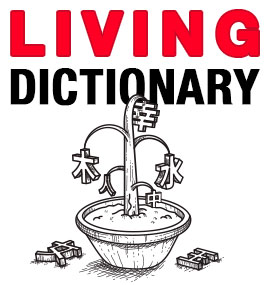
Our Chinese Dictionary is Alive!
Welcome to the first and only living Chinese dictionary that is growing every day with its Chinese learners. You have the opportunity to contribute ways that you remember Chinese characters and photos of your Chinese writing as you learn from other students of Chinese. Click the “Learn More” button next to any character to see what others have said about that character. Try to be the first to share your Chinese learning wisdom with the community!
- Chinese Characters with 1 Stroke
- Chinese Characters with 2 Strokes
- Chinese Characters with 3 Strokes
- Chinese Characters with 4 Strokes
- Chinese Characters with 5 Strokes
- Chinese Characters with 6 Strokes
- Chinese Characters with 7 Strokes
- Chinese Characters with 8 Strokes
- Chinese Characters with 9 Strokes
- Chinese Characters with 10 Strokes
- Chinese Characters with 11 Strokes
- Chinese Characters with 12 Strokes
- Chinese Characters with 13 Strokes
- Chinese Characters with 14 Strokes
- Chinese Characters with 15 Strokes
- Chinese Characters with 16 Strokes
- Chinese Characters with 17 Strokes
- Chinese Characters with 18 Strokes
- Chinese Characters with 19 Strokes
- Chinese Characters with 20 Strokes
- Chinese Characters with 21 Strokes
- Chinese Characters with 22 Strokes
- Chinese Characters with 23 Strokes
- Chinese Characters with 24 Strokes
- Chinese Characters with 25 Strokes
- Chinese Characters with 26 Strokes
- Chinese Characters with 27 Strokes
- Chinese Characters with 28 Strokes
- Chinese Characters with 29 Strokes
- Chinese Characters with 30 Strokes
- Chinese Characters with 31 Strokes
- Chinese Characters with 32 Strokes
- PRO Courses Guides New Tech Help Pro Expert Videos About wikiHow Pro Upgrade Sign In
- EDIT Edit this Article
- EXPLORE Tech Help Pro About Us Random Article Quizzes Request a New Article Community Dashboard This Or That Game Popular Categories Arts and Entertainment Artwork Books Movies Computers and Electronics Computers Phone Skills Technology Hacks Health Men's Health Mental Health Women's Health Relationships Dating Love Relationship Issues Hobbies and Crafts Crafts Drawing Games Education & Communication Communication Skills Personal Development Studying Personal Care and Style Fashion Hair Care Personal Hygiene Youth Personal Care School Stuff Dating All Categories Arts and Entertainment Finance and Business Home and Garden Relationship Quizzes Cars & Other Vehicles Food and Entertaining Personal Care and Style Sports and Fitness Computers and Electronics Health Pets and Animals Travel Education & Communication Hobbies and Crafts Philosophy and Religion Work World Family Life Holidays and Traditions Relationships Youth
- Browse Articles
- Learn Something New
- Quizzes Hot
- This Or That Game
- Train Your Brain
- Explore More
- Support wikiHow
- About wikiHow
- Log in / Sign up
- Education and Communications
- World Languages
How to Learn to Read and Write Chinese
Last Updated: April 26, 2024 References
This article was co-authored by Tian Zhou . Tian Zhou is a Language Specialist and the Founder of Sishu Mandarin, a Chinese Language School in the New York metropolitan area. Tian holds a Bachelor's Degree in Teaching Chinese as a Foreign Language (CFL) from Sun Yat-sen University and a Master of Arts in Teaching English to Speakers of Other Languages (TESOL) from New York University. Tian also holds a certification in Foreign Language (&ESL) - Mandarin (7-12) from New York State and certifications in Test for English Majors and Putonghua Proficiency Test from The Ministry of Education of the People's Republic of China. He is the host of MandarinPod, an advanced Chinese language learning podcast. This article has been viewed 28,774 times.
Have you ever found Chinese very hard with all the confusing characters? Mandarin Chinese is the most spoken language in the world, so it is definitely worth learning. Chinese is not very easy to learn, but in this wikiHow, it will teach you the reading and writing basics to learning Chinese.
Learning to Read and Write Chinese

- It is useful for Chinese language learners, as it allows you to get started with reading and writing Chinese without the time involved in learning traditional characters. There are many Chinese textbooks and learning materials available in Pinyin.
- However, it is important to be aware that even though Pinyin uses letters from the Roman alphabet, its pronunciation is not always intuitive to the English speaker. Therefore, it is important to use a proper pronunciation guide when learning Pinyin.

- Learning to recognize and read Chinese characters is no easy task. In order to read a newspaper, the average Chinese reader will need to be familiar with about 2000 different characters—and that's just the beginning. It is believed that there are over 50,000 Chinese characters in total (though many of them are no longer in use).
- The major benefit of learning to read Chinese characters is that you will have access to a broad array of other literatures, including Cantonese, Japanese and Korean—all of which use Chinese characters (or a simplified version of them) in their writings, despite the fact that the spoken languages are very different.

- The first step in learning how to write Chinese characters is to learn the "radicals"—these are the individual brush strokes that form the building blocks of each character. There are 214 radicals in total—some can stand on their own as individual characters, while others are only used as part of a more complex character.
- When writing Chinese characters, the order of the brush strokes is very important and you must follow a specific set of rules—such as top to bottom, left to right, and horizontal before vertical. If the stroke order is incorrect, the completed character will not be accurate.

- To begin with, you could try using some children's readers or workbooks (which are nearly always written in Pinyin) to practice your basic reading skills. You should also be able to find some good resources for reading Chinese online.
- You can also try to incorporate your Chinese learning into your everyday life. You can do this by reading the Chinese labels on food products at the Asian supermarket, or asking your server for the Chinese language menu at a restaurant.
- Once your reading becomes more advanced, you could try to get your hands on a Chinese newspaper (which are printed using traditional Chinese characters) and do your best to read through the articles. This is also a good way of familiarizing yourself with Chinese culture and current affairs.

- One option is to keep a small personal diary in Chinese, where you write down simple things like a description of the weather, how you are feeling that day, or what you did. If you're not too shy about it, you could ask a Chinese-speaking friend or acquaintance to look it over and check for any mistakes.
- Alternatively, you could try to find a Chinese pen-pal to write letters to. This could be mutually beneficial, as you could get some practice writing in Chinese, while your pen-pal could practice their English. You could also ask your pen-pal to include the corrected version of your original letter when replying.
- A last way of practicing your writing is to make simple lists in Chinese, like your shopping list, or to make Chinese labels for items around the house.
Immersing Yourself in Chinese

- If you have a Chinese-speaking friend, ask them if they'd be willing to sit down with you for an hour or two each week. They'd probably be happy to help—as long as the coffee's on you!
- If you don't know any Chinese speakers personally, you could try placing an ad in your local paper or online forum. Alternatively, you could look into finding a Chinese conversation group or oral Chinese class in your local area.
- If all else fails, you could try to connect with a Chinese speaker on Skype, one who'd be willing to exchange 30 minutes of Chinese conversation for 30 minutes of English.

- It doesn't matter if you can't follow everything that's being said— try to be an active listener and attempt to pick out keywords and phrases. Slowly but surely, your overall comprehension will improve.
- This is a great option for people who have long commutes as they can simply stick a Chinese CD on in the car or listen to a Chinese podcast on the train. You could also try listening while exercising or doing housework.

- Try watching short cartoons or clips on YouTube, or rent a full length Chinese film from your local movie store. You may need to use subtitles at first, but try not to rely on them too much—see how much of the dialogue you can understand on your own.
- If you're feeling particularly proactive, you could pause the film after particular words or phrases and try to repeat them—this will help your accent to sound more authentic.

- You need to try to overcome this fear—and even embrace it—if you are to reach your goal of fluency.
- Remember that everyone makes mistakes when they are learning a new language. You are bound to have your fair share of embarrassing mistakes and awkward moments, but this is all part of the process.
- Remember that you are not aiming for perfection when you are learning Chinese, you are aiming for progress. So, go ahead and make as many mistakes as you like—as long as you learn from them and continue to improve.

- China is an amazingly diverse country—from the busy, bustling streets of Beijing to the ancient majesty of the Great Wall. There is something for every traveler—whether you're looking to immerse yourself in traditional ethnic cultures, to sample the many delicious Chinese delicacies, or to travel to the sites of ancient ruins and epic battles.
- Alternatively, you could take a tour of other places with large Chinese-speaking populations, like Taiwan, Malaysia, Singapore and the Philippines. Just make sure that you are prepared for differences in dialect (not all are mutually intelligible) before you book your flight!
Expert Q&A

Reader Videos
- Although there are many dialects, the characters are almost identical. Thanks Helpful 1 Not Helpful 0
- Do not expect to learn Chinese very quickly. Learning a language will take time. Thanks Helpful 1 Not Helpful 0
- Practice with a native speaker. This can make pronunciation a lot easier. Thanks Helpful 1 Not Helpful 0

- Mandarin and Cantonese are 2 of the main dialects of Chinese. Spoken, they are completely different (with some exceptions)! Cantonese has 6 main tones. Most of mainland China uses Mandarin, and mainly Hong Kong and Macau uses Cantonese. However, almost everyone in China is educated in Mandarin in school, so Mandarin is the most useful dialect to learn if you want to be able to speak to people almost anywhere. Thanks Helpful 2 Not Helpful 0
- Not in every region in China people speak Mandarin Chinese. There might be some confusing dialects, so be careful. Thanks Helpful 2 Not Helpful 0
You Might Also Like

- ↑ http://blog.tutorming.com/mandarin-chinese-learning-tips/what-is-pinyin
- ↑ https://www.writtenchinese.com/how-to-read-chinese-characters-a-beginners-guide/
- ↑ http://www.zhongwen.com/shufa/
- ↑ Tian Zhou. Language Specialist. Expert Interview. 19 March 2021.
- ↑ https://journals.plos.org/plosone/article?id=10.1371/journal.pone.0158409
- ↑ https://www.chinahighlights.com/travelguide/chinese-language/cantonese-vs-mandarin.htm
About This Article

- Send fan mail to authors
Did this article help you?

Featured Articles

Trending Articles

Watch Articles

- Terms of Use
- Privacy Policy
- Do Not Sell or Share My Info
- Not Selling Info
wikiHow Tech Help Pro:
Level up your tech skills and stay ahead of the curve
Chinese Writing
The written Chinese language is one of the oldest active languages today, dating from the Shang Dynasty, more than 3,000 years ago, and is used by approximately 1.3 billion people today. Chinese characters in the written language can be very intricate, ornate and beautiful; therefore it is really no surprise that writing the characters is considered an art form, known as Chinese calligraphy.
The Art of Chinese Written Characters
The literal definition of the word calligraphy is simply "good writing", but in the sense of Chinese calligraphy, the meaning goes deeper than simply writing the characters, or even striving to make the characters look beautiful. It is considered to be an art form requiring mental disciple, which involves both the body and soul.
Chinese written characters have a unique ability to express spiritual feelings and other emotions as well as character and integrity, and can even convey the temperament of the one doing the writing. The Chinese art of calligraphy (书 shu /shoo/), which is also called brush calligraphy, is unique to the Asian culture and the most treasured of the four arts of Chinese literati, which include painting (画 hua /hwaa/), playing a musical instrument (琴 qin /chin/) and playing strategic board games (棋 qi /chee/).
Tools Used for the Art of Chinese Calligraphy
Since Chinese calligraphy is an art, there are special tools required that have been used from ancient times to the present. These four tools are called the the Four Treasures of the Study (文房四宝 wenfang si bao /wnn-fung srr baoww/).
The ink stick is the writing instrument and is solid ink made from oil smoke or pinewood soot. The ink stone contains the ink, which is obtained by using water and grinding the stick on the stone. The brush is made of bamboo and animal hair from deer, sheep, rabbits or wolves, depending on the weight of the stroke needed. A special absorbent paper called xuan paper is used.
Although some might consider writing with a brush an ancient practice, recent studies showed that twenty million Chinese were still using the brush and ink stick.
Formation of Chinese Characters
There are five general styles that are traditionally used in Chinese calligraphy, which are zhuan shu, kai shu, xing shu, li shu, and cao shu. Each of these have their own special characteristics, and are derived from different origins dating back to different dynasties.
Seal Characters (篆书 zhuan shu /jwann shoo/)
This style gets its name from the ancient for of charactersused in official seals. Seal characters are very popular with calligraphy artists for their elegant style and are divided up into both small seal and big seal characters.
- Small seal characters are also know as Qin Seal, so named because they go back to the Qin Dynasty (221 - 206 BC). Small seal characters are more simple and standard than big seal.
- Big seal characters have their foundation in oracle bone inscriptions and date back to the Zhou Dynasty (1046 - 256 BC).
Formal Script (楷书 kai shu /keye shoo/)
Kai Shu, otherwise known as Zheng Shu script, evolved from seal characters. Kai Shu is known for its squareness, and horizontally and vertically standardized structure. Its simplicity makes it a neat and orderly way of writing, which is possibly why it is also very popular with calligraphers.
Running Script (行书 xing shu /sshing shoo/)
Xing shu is the cursive form of kai shu, thereby making it a very quick, convenient, and practical way of writing. However, if xing shu is written carefully and deliberately it looks very much like kai shu. Xing shu comes from the Han Dynasty (206 BC - 220 AD).
Cursive Hand (草书 cao shu/tsaoww shoo/)
Another cursive form of calligraphy, cao shu also goes back to the Han Dynasty. Although it had its origins with the Western Han Dynasty (206 BC - 8 AD), it did not become popular until the Eastern Han Dynasty, between 25 and 220 AD. Cursive hand is very simple, irregular and sketchy, yet highly artistic.
Official Script (隶书 li shu /lee shoo/)
The strongest characteristic of li shu is its diversity. Although it has a neat look, it is a more complex type of writing with its different variations. Li shu became the writing which eventually transitioned into formal script. Once again the Eastern Han Dynasty is credited with this style of writing.
- 11-Day China Classic Tour
- 3-Week Must-See Places China Tour Including Holy Tibet
- 8-Day Beijing–Xi'an–Shanghai Private Tour
- How to Plan Your First Trip to China 2024/2025 — 7 Easy Steps
- 15 Best Places to Visit in China (2024)
- Best (& Worst) Times to Visit China, Travel Tips (2024/2025)
- How to Plan a 10-Day Itinerary in China (Best 5 Options)
- China Weather in January 2024: Enjoy Less-Crowded Traveling
- China Weather in March 2024: Destinations, Crowds, and Costs
- China Weather in April 2024: Where to Go (Smart Pre-Season Pick)
- China Weather in May 2024: Where to Go, Crowds, and Costs
- China Weather in June 2024: How to Benefit from the Rainy Season
- China Weather in July 2024: How to Avoid Heat and Crowds
- China Weather in August 2024: Weather Tips & Where to Go
- China Weather in September 2024: Weather Tips & Where to Go
- China Weather in October 2024: Where to Go, Crowds, and Costs
- China Weather in November 2024: Places to Go & Crowds
- China Weather in December 2024: Places to Go and Crowds
Get Inspired with Some Popular Itineraries
More travel ideas and inspiration, sign up to our newsletter.
Be the first to receive exciting updates, exclusive promotions, and valuable travel tips from our team of experts.
Why China Highlights
Where can we take you today.
- Southeast Asia
- Japan, South Korea
- India, Nepal, Bhutan, and Sri lanka
- Central Asia
- Middle East
- African Safari
- Travel Agents
- Loyalty & Referral Program
- Privacy Policy
Address: Building 6, Chuangyi Business Park, 70 Qilidian Road, Guilin, Guangxi, 541004, China
Learn to write Chinese the easy way!
Our Chinese language worksheets, flashcards and exercises are engaging, fun, easy-to-use and free!

Sign up to receive the latest updates, collections and worksheets sent directly to your inbox.
Chinese Radicals provide helpful hints to the meaning and sound of many characters. Learning the most common Chinese Radicals will help you memorize and recall Chinese characters faster! Don't wait! Learn these radicals now to start learning Chinese faster!
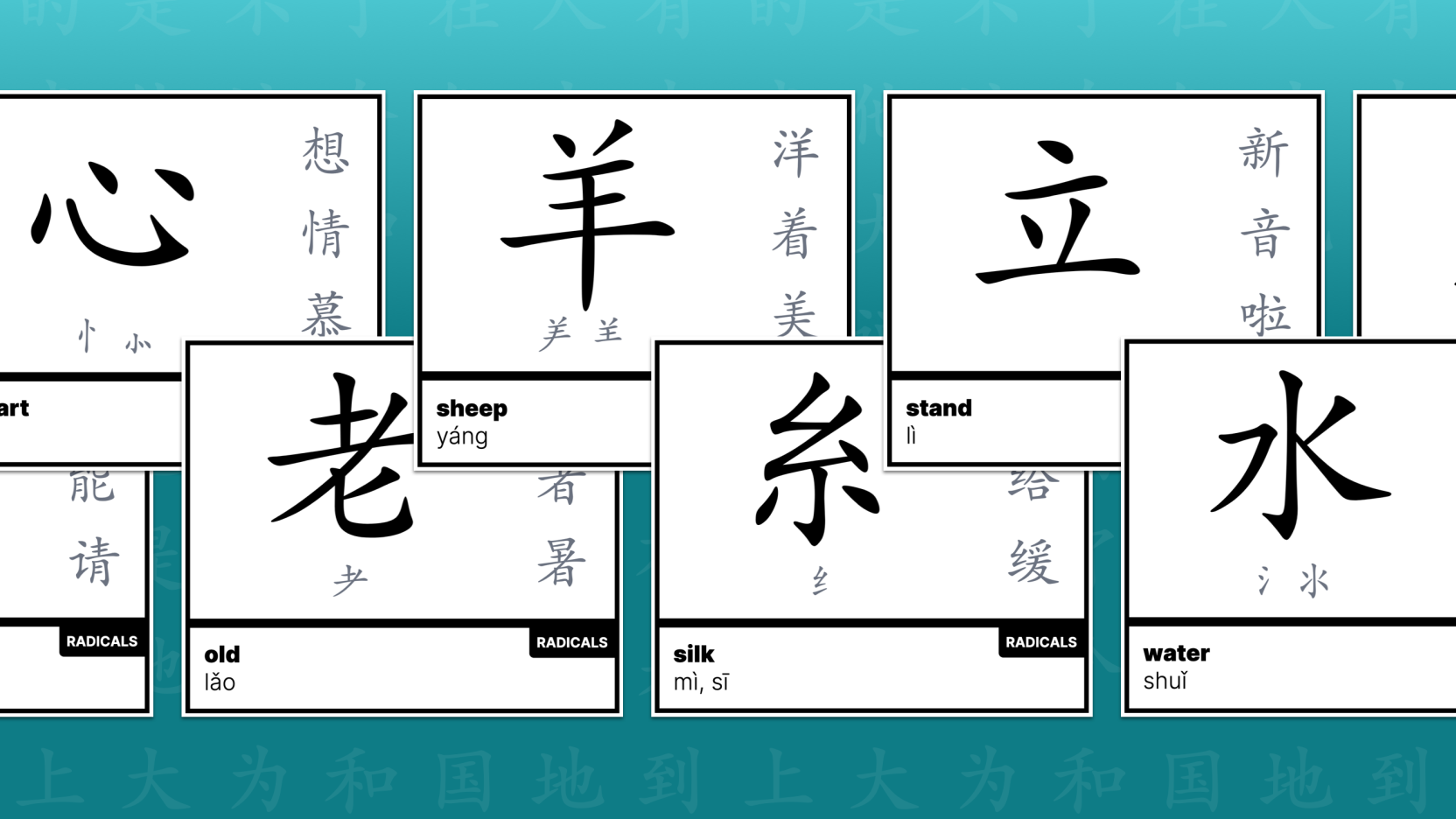
Newest Collections

HSK 4 Verbs (Set 1)
Learn how to write 14 HSK 4 verbs in simplified or traditional Mandarin Chinese.

Demonstrative & Interrogative Pronouns
Learn how to write 7 demonstrative and interrogative pronouns in simplified or traditional Mandarin Chinese.

Sports Actions (Set 2)
Learn how to write 10 sports and exercise actions in simplified or traditional Mandarin Chinese.

Sports Actions (Set 1)

Types of Flowers (Set 2)
Learn how to write 9 types of flowers in simplified or traditional Mandarin Chinese.

Types of Flowers (Set 1)
Learn how to write 10 types of flowers in simplified or traditional Mandarin Chinese.
Newest Worksheets

field, farm

- Collections
- The Fine Print
© 2021 WriteMandarin • All rights reserved.

5 Easy Steps to Master Chinese Characters Writing as a Beginner!
Chinese characters are based on radicals, each with its own meaning. These radicals are combined into characters and words. To learn Chinese writing, one must first master strokes, which are a set of line patterns arranged to form characters. Mastering these strokes and understanding the logic behind radicals makes learning Chinese writing easier.
Step 1: Understanding the Basics of Chinese Characters
Chinese characters are more than just symbols; they are a beautiful amalgamation of art and meaning, where form and function are deeply interconnected.
The Building Blocks: Strokes and Radicals
Each Chinese character consists of several strokes, which are the basic units of Chinese writing. Think of these strokes as the alphabet of the Chinese language. There are several types of strokes, including horizontal (一), vertical (丨), and various hooks and curves. Learning these strokes is like learning the foundation of building blocks.
Radicals are components of Chinese characters that often hint at the meaning or sometimes the pronunciation. For example, the radical ‘心’, meaning heart, is found in emotions or feeling-related characters like ‘想’ (think), ‘忘’ (forget), and ‘怒’ (angry).
The Crucial Role of Stroke Order
Following the correct stroke order is crucial as it facilitates easier learning and memorization, helps maintain the balance and integrity of the more complex characters, and speeds up writing. Characters should be written from top to bottom, and left to right. This not only makes writing smoother but also ensures that the characters look balanced and aesthetically pleasing when completed.
Step 2: Start with the Most Common Characters
Familiarizing yourself with the most commonly used characters first can significantly boost your reading and writing speed.
Focus on High-Frequency Characters
Starting with high-usage characters such as ‘是’ (shì, is), ‘有’ (yǒu, have), and ‘我’ (wǒ, I/me) can help beginners quickly start forming basic sentences. These characters appear frequently across various contexts, providing new learners with the immediate utility of their knowledge.
Learning in Context
Always learn characters within the context of phrases or sentences. This approach not only makes the learning process more interesting but also enhances understanding. For instance, learning the character ‘开’ (open) within the phrase ‘开门’ (kāi mén, open the door) helps solidify its meaning and use.
Step 3: Practice Daily with a Focus on Quality
Consistent practice is essential for mastery, especially with something as intricate as Chinese characters.
Establishing a Routine
Consistency is key. Dedicate specific times of the day for practice and stick to them. Over time, this regular practice becomes a habit, integrating Chinese writing into your daily routine seamlessly.
Techniques for Effective Practice
Focus on the quality of each character you write. It’s better to write one character perfectly ten times than to hurriedly write it fifty times with poor form. Tools like practice grids are very helpful in maintaining proportions and alignment.
Step 4: Use Technology to Enhance Learning
Leveraging technology can provide interactive and effective learning experiences.
Digital Practice Tools
Digital tools that simulate the writing experience can be highly effective. These tools often provide instant feedback on stroke order and character accuracy, features that are incredibly beneficial for self-directed learners.
Incorporating Audio-Visual Aids
Multimedia resources that combine text, sound, and visual animations can greatly enhance the learning experience. Hearing the pronunciation while seeing the character helps in reinforcing memory through multiple sensory engagements.
Step 5: Engage with Chinese Culture
Understanding the cultural context behind the characters can enrich the learning experience and provide deeper insights into the language.
Cultural Immersion through Media
Engage with media such as Chinese films, music, or literature. This exposure not only improves language skills but also helps you appreciate the nuances of character usage in different contexts.
Real-World Application
Applying what you’ve learned in real-world situations is perhaps the most effective way to solidify knowledge. Try labeling items around your home with their Chinese characters or write short notes or messages in Chinese.
Mastering Chinese characters is a journey that can open up new perspectives and connections with one of the world’s oldest cultures. With patience, practice, and the right resources, anyone can learn to write Chinese characters beautifully and effectively. Embrace each step of this journey with curiosity and enthusiasm, and watch as the world of Chinese language unfolds before you.
Additional Resources
- Language exchange programs can be a valuable resource for practical experience.
- Regular quizzes and writing challenges can help assess your progress and reinforce learning.
Remember, the key to mastering Chinese characters lies in understanding their artistic and cultural significance as much as their linguistic function. Keep practicing and exploring, and the rewards will be both profound and enriching.
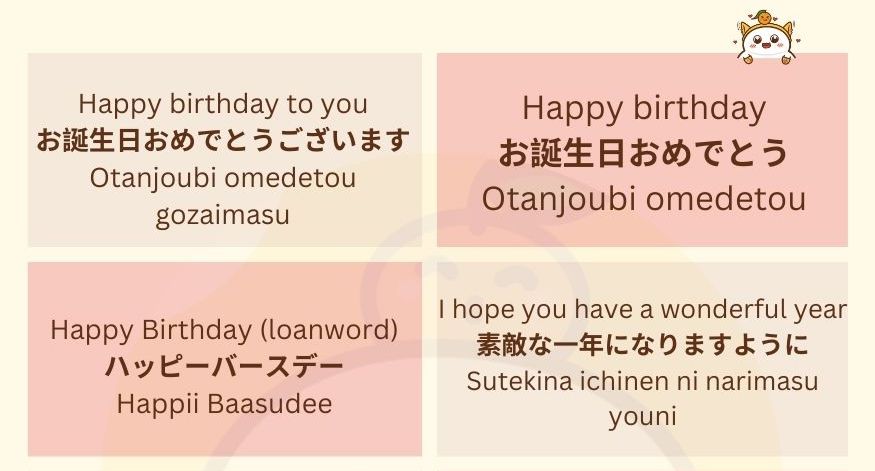
Related Articles
Essential guide to chinese toilets: preparing for your trip to china, the ultimate guide to saying “shut up” in chinese – from movies to streets, all about chinese national anthem, post comment cancel reply.
Save my name, email, and website in this browser for the next time I comment.
Use this tool to add tone marks to pinyin or to convert tone number (e.g. hao3) to tone marks.
Although you can use the red buttons to add tone marks, we highly recommend you use the number method (e.g. hao3) for speed and placement of the accent above the correct vowel. [Hint: Type "v" for "ü"] Note: You do not need to use this tool to enter pinyin in this dictionary.
- Latest Posts
- Learner Tips
- Culture Lessons
How to Read Chinese Characters: A Beginner’s Guide

I t will only take [est_time] to read this post!
Learning to read Chinese characters is something that many students of Chinese, who often just begin learning to speak, are reluctant to show interest in. I was one of those ‘students’ if I can even call myself that, who started to learn Chinese out of necessity. Once I got over the idea that learning to read Chinese was impossible, I realized how much easier my life had become in China, and how liberating it was to read even just a handful of Chinese characters.
Of course, no one’s suggesting it’s an ‘easy’ journey. There are plenty of avenues to go down before being able to read, and below are some of the ‘stages’ you might want to visit while learning to read Chinese characters.
Before starting to read, you need to decide whether you’ll learn to read simplified or traditional Chinese characters. The chances are that you’ll automatically choose to learn simplified characters since this is the written language used in mainland China. After all, they are ‘simplified.’ However, don’t forget to take a look at traditional characters , especially later down the line.
First…
UNDERSTAND HOW CHARACTERS WORK
Let me take you back to 2011 when I first arrived in China. I had no intention of learning to read Chinese characters because back then, written Chinese looked like this:

Chinese characters are pictures
Chinese characters are made up of small pictures on an elementary level, some literal while others are quite abstract.

Chinese characters can be ‘broken down’ into separate parts
As mentioned above, Chinese characters are made up of small pictures that make a full character. These ‘separate parts’ each have their own meaning or pronunciation.

The separate parts have their own meaning
In every character, there is at least one ‘part’ that suggests the ‘meaning’ of a character. Sometimes, there is more than one’ part’ of a Chinese character that suggests meaning, and these are often part of a more complex and abstract idea.

One ‘part’ provides pronunciation
At least one’ part’ of a character helps the reader know how to speak the character. This ‘part’ is often on the right-hand side of a character.

Balance is important in a character
The balance in a character can help us read, as it allows the ‘breakdown’ of a character.

These are just guidelines, and as you learn to read more Chinese characters, you’ll find many that don’t fit this rule.
START WITH PICTOGRAPH CHARACTERS
When I first started learning to read Chinese characters, my teacher first introduced me to characters known as pictographs. These are characters that basically look like the object’s name, making them a. fun to learn and b.easier to remember.
Pictographs or pictograms were the first Chinese characters that show objects in their most rudimentary form. Although some pictographs have changed from their original bone oracle characters, most are still related to the word they depict.
The following are examples of pictograph characters:

I suspect that at first glance, you may not make the connections, but once you learn their meanings, you’ll be face-palming with an ‘oh, yeah!’

What did I tell you?
Well, that’s the reaction I had anyway, and the realization that Chinese characters had a meaning that I could actually understand was one of the reasons why I stuck with learning to read Chinese.
You can get started learning pictographs in ‘ Learn to Read with these 20 Chinese Pictographs’.
The reason why I recommend learning pictographs first is that many of them are also radicals, which you also need to know. Of course, you can learn radicals first , but pictographs are an excellent ‘unscary’ introduction to Chinese characters that served me well!
LEARN RADICALS
A significant step of learning to read Chinese characters is to understand radicals. No, not the revolutionary type, the ones that we like to call the ‘building-blocks’ of Chinese characters. Learning radicals is probably the next best step because after learning the pictographs, characters begin to get bigger and slightly more complex, but NOT impossible !
There are approximately 214 radicals in Chinese, which may seem a lot. Still, once you have learned around one-quarter of these radicals, you might want to continue learning the remainder simultaneously with the characters in the step below.
Get your free 214 Radical List PDF
Radicals generally provide you with the ‘meaning’ of a character, or sometimes the pronunciation. When I say ‘meaning,’ there are times when this will only be a mere hint, and the origins of these characters (depending on the person) may need to be studied in more detail in order to understand it fully. It often helps to look at the traditional version to see the origins of a character.
For example, the simplified character 东 (dōng) meaning ‘east’ doesn’t really help us find meaning, whereas looking at the traditional character, 東 will help you deduce meaning and create a story.

Suppose you find the origins of characters fascinating. In that case, I really recommend taking a look at the Fun with Chinese Character book series that breaks down characters, often considering Chinese culture and going back to the bone oracle where possible.
I don’t think that it’s necessarily imperative to look at the origins of a character to help you remember it. You can use other methods to help you read characters, such as this ‘story’ method .

COMBINED IDEOGRAPHS AND ABSTRACT CHARACTERS
Once you’ve learned some pictographs, you’ll soon be able to put some of them together (or break them apart) to learn more complex characters, known as 会意 (huì yì) combined Ideographs or ‘meeting of ideas.’ These are characters that combine two or more pictographs or ideographs to make a new character.

These are the most enjoyable characters to learn, as there is often interesting (and sometimes entertaining) logic behind their creation.
This is also the most natural progression of study and learning some of the more advanced radicals.
Build on the pictographs and radicals that you’re studying to learn these compound characters.
You can learn more about pictographs, combined ideographs, and the other types of Chinese characters here .
PRONUNCIATION ON THE RIGHT SIDE
As I mentioned in the five steps at the beginning of my post, a Chinese character also tells us how to pronounce the character, which is an essential part of learning to read.
Once you’ve built up several characters in your’ bank,’ you’ll soon be able to take a good stab at ‘guessing’ the pronunciation of a character.
Characters that combine pictographs and phonetics are known as 形声 (xíng shēng) or Determinative-Phonetic characters.

You’ll probably find that some radicals act mostly as the ‘determinative’ part of the character, such as 木 the tree radical . In contrast, others appear mainly for the pronunciation, like the 工 (gōng) radical.
It’s fair to say there are some tricksters out there that will only provide you with a ‘hint’ of how to pronounce the character.
For example, some characters have very similar pronunciation:
The pronunciation of 任 rèn is 壬 rén. The only difference is a slight change from the second tone to the fourth tone ( learn more about tones here ).
However, there are examples such as 部 bù, that has the 阝 fù sound as its pronunciation.

Once you’ve started to read Chinese characters, remembering them all can become a challenge! There are several methods below that you can try to make reading and remembering characters a little easier!
CREATE MNEMONICS
As mentioned earlier, as Chinese characters are made up of small ‘pictures,’ it is easier to create ‘stories’ around a character. You can be as creative or as literal as you want with these mnemonics, as they’re your personal method of remembering a character.

This reminds me of a game I used to play when I was teaching English, which involves the student rolling several dice with tiny pictures on each face instead of numbers. The student then has to create a story based on these pictures.
Why not give it a go?
LOOK TO BIGRAMS INSTEAD OF SINGLE CHARACTERS
You might not have come across ‘bigrams’ before, but these are 2-character combinations that makeup ‘words’ in Chinese. Although some words are single characters, a bigram offers more clarification to the meaning.
For example, 会 (huì) has many meanings, including ‘can,’ ‘to meet’ and ‘union.’
To clarify the meaning of 会 (huì), take a look at the bigrams that contain the character:
社会 (shè huì) society
不会 (bù huì) unlikely
会议 (huì yì) meeting
This makes learning bigrams more practical AND easier, as you don’t need to struggle to understand the meaning behind a character that has little meaning!
Learn more about studying bigrams .
CHOOSE A STUDY PATH
If you’re just studying for fun, you may not want to choose a ‘path’ and continue to learn along the route you’re on now. However, studying a course or specific field of characters may provide you with more direction .
One of the more popular systems to follow is HSK, an exam system of six levels. Beginning with HSK 1, you can study characters in chunks , which is perfect for beginners as you’re also learning characters used in everyday life.
All the HSK vocabulary lists are free to study and review , and you can use it to learn Chinese characters even if you choose not to take an exam .

Most Common Characters / Most Common Bigrams
An alternate study method is to follow MIT’s list of most common Chinese characters found in print, which is great if you’re just learning to read.
Do you have a method for how to read Chinese characters? Please share it with us below!
About Hollie
Get Your Radical List PDF
Study all 214 Chinese radicals with this free list. Includes English translations, pinyin and variations.
By signing up you'll receive occasional updates, special offers and Chinese learning tips from us.

How to Write in Chinese in Windows 10 (and 11)
My dad asked me how to write Chinese in Windows 10 and to my chagrin as a Microsoft fanboy, I did not know. I searched the web and YouTube, and while I eventually figured out what to do I surprisingly did not encounter one short and simple tutorial on doing so. Hence, this quick article and video.
As it turns out, writing Chinese in Windows 10 is exceedingly easy ! Ignore the articles that say you need to download third-party software or buy some sort of specialized writing pad, or talk about IME (“Input Method Editor”)—whatever that is. If you have a Windows tablet or 2-in-1 like the Microsoft Surface, you can easily write Chinese using a stylus or finger and Windows will automatically convert your handwriting to typeface. Or, if you don’t have a touch screen, you can type in Pinyin instead.
Overview of the Procedure
- Add Chinese language to your device
- Either (a) click on the virtual keyboard in the taskbar, select Chinese and select the handwriting icon, then start writing Chinese with a stylus, or (b) select Chinese in the taskbar, start typing in Pinyin, and select from a list of Chinese character that could correspond to that Pinyin.
Here is a video of the above.
I actually prefer Option 2b (typing in Pinyin) above since I know how to write very few Chinese words, but know how to say some and can sort of recognize the most basic ones. Of course, a native Chinese person would probably prefer writing with a stylus or finger.
There are 9 comments.
Thanks Felix for the video, my dad asked me the same question. Gifted him a surface and he gave it back to me unable to understand how to use. Want to transition him and your video will go along way!! ↩ Reply
Hi Karin. That's funny; I had originally created the video for my dad too! Hope it helps your dad.
Thanks for stopping by my blog and for your comment! ↩ Reply
You rock! ↩ Reply
if i dnt know PinYing, and don't have Windows tablet or 2-in-1 like the Microsoft Surface, I only have a rugular laptop, no touch screen. can i still use Wrting Pad build in laptop?
Do i need to download the Appl or change key broad to do Chinese Hand Writing? ↩ Reply
Thanks for stopping by my blog and for your comment!
Regarding your question, without a touchscreen, it still is possible to use the drawing method that I showed in the video. But you would have to draw the character with your mouse or built-in touchpad instead of using your finger or stylus. As you can imagine, that would be a lot more awkward.
That would probably work fine if you were infrequently entering Chinese characters.
Another method I have used that is imperfect is to type English into Google Translate, find the Chinese characters I want, and copy and paste. Depending on what you are trying to do, that might be adequate also.
If you do a lot of writing of Chinese, however, I would highly recommend getting a laptop with a touchscreen and a stylus. Most Windows laptops have a touchscreen nowadays. ↩ Reply
Q: The problems are new and centered on its mistaking the initial radical as a word before an handwritten input is even completed. ↩ Reply
I've experienced the same problem you had, with Windows mistaking the initial radical as a separate word. I could avoid it by writing the radicals closer together. Also, writing quicker seemed to help too.
But there are not many Chinese words I can write freehand. I rely entirely on the Pinyin input method! ↩ Reply
Since I upgraded to Win 10 Pro, none of my Widows devises allow Traditional characters using pinyin. Been stuck with simplified characters.
Even worse, my separate pen pad, I was using with my desktop to learn to write, no longer worked
On my wife's new Win11 laptop being older, unless a tab or fold over laptop, will cause ergonomic shoulder damage. That's why I discouraged her from buying a touch screen laptop. Using Apple & Google tablets & phones, she puts them flat on table writing entire character.
For a Win 11 laptop, would make sense to use stylus on built in laptop mouse area, using wireless mouse
What would be great for a desktop, is a cheap Android tablet, being a wireless pen pad Mouse
Win 11 supporting Android, allows use of the best possible bilingual program HAN IZ, by Embere ↩ Reply
Thanks for your comment and your tips!
I agree that touchscreen laptops are not ergonomic to write on unless it is a convertible 2-in-one.
I have since moved on to an iPad Pro for all my "computer" needs. ↩ Reply
Leave a comment Cancel reply
How to Write a Formal Email in Chinese

- 房产项目合作机会 (fáng chǎn xiàng mù hé zuò jī huì) - Opportunity to Cooperate on Real Estate Projects
- 居外公司简介 (jū wài gōng sī jiǎn jiè) - Company Bio of Juwai
- 孔子学院奖学金的申请资料 (kǒng zǐ xué yuàn jiǎng xué jīn de shēn qǐng zī liào) - Application Materials for the Confucius Institute Scholarship
- 申请财务经理招聘广告 (shēn qǐng cái wù jīng lǐ zhāo pìn guǎng gào) - Application for Financial Manager Job Posting
- 期末考试日期 (qī mò kǎo shì rì qī) - Date of the Final Exam
- 语言交换伙伴 (yǔ yán jiāo huàn huǒ bàn) - Language Exchange Partner

Option 3: Generic, Formal
Option 4: Generic, Formal
Option 5: Other Specific Titles, Formal/Informal
We’re not done just yet!
So, we can say things like:

Example 1 - Thank You Letter for Business
谢谢贵公司送的月饼,我们今天收到了!我们很期待下个月的会议,到时候我们请客!
Example 2 - Outreach Letter for Business
Example 3 - Email for Business
Example 5 - Email for Teacher
At the end of the month, I’ll be going abroad, so I’d like to make sure there’s no issue with the time.
Other Useful Sentences for the Body
Here are some go-to sentences you can use in your emails:

Other Options for Emails

If you’re just getting started learning Chinese, check out our Beginner Conversational Course to build a strong foundation in pinyin, the tones, and the conversational language you’ll use most often! You can achieve basic conversational fluency in just SIX months!
Level 1 of the course takes about 1 month to complete, studying 30 minutes a day - and is FREE ! - so start now .
Interested in learning Chinese characters as well? Check out our Chinese Character Course I , where we teach you the 300 MOST common Chinese characters . The first few lessons are free!

Free Lessons

Free Downloads
Popular Posts

What our students have to say
Join us and have fun learning chinese.

IMAGES
VIDEO
COMMENTS
In Chinese writing, you need to learn the strokes and strokes orders first. Only then, you will know how to write Chinese characters in the correct way. After that, you also need to study the radicals and the logic behind them. You can also make good use of pictograms image to help you remember the characters easily.
Takeaway to Improve Chinese Essay Writing. Keep an excel spreadsheet of 口语 (Kǒuyǔ, spoken Chinese) -书面语 (Shūmiànyǔ, written Chinese) pairs and quotes of sentences that you like. You should also be marking up books and articles that you read looking for new ways of expressing ideas. Using Chinese-Chinese dictionaries is really ...
First we went from components to characters. Next, we are going from characters to words. Although there are a lot of one-character words in Chinese, they tend to either be classically-rooted words like "king" and "horse" or grammatical particles and pronouns. The vast majority of Chinese words contain two characters.
Here are tips to help you get better at writing essays in Chinese. Cover image from Pexels Learn New Chinese Words. The key to communicating in a new language is learning as many words as you can. Take it upon yourself to learn at least one Chinese word a day. Chinese words are to essay writing what bricks are to a building.
Chinese Essay Phrases Used in Abstracts. The abstract should explain the purpose, method, results, and conclusion of your research, also highlighting the new ideas that you proposed; and do remember to keep your language concise while writing. The purpose of the abstract is to conclude and summarize the main contents of your essay so that the ...
2. Determine the center, choose the right material. To conform to the fact that a typical, novel, so it's easy to attract the attention of people. 3. Make a good outline, determine the general, write enough words. 4. Sentence writing smooth, there is no wrong character, no wrong grammar in article. Emotion, it is very important.
Avoid perfectionism and performance anxiety - Many people feel that their writing is not good enough or that the result needs to be perfect. This is because they think of it as a product, rather than a process. Don't wait for the perfect situation to write, the perfect topic, the perfect mood, and so on.
Once you can write the answers to the above down on a single side of the paper, you are ready to tackle the main part of the problem: putting pen to paper. Set aside time to write. The chances are that you're not going to be able to pen the entire essay in a single sitting, and that's okay.
Remembering Simplified Hanzi 1. This book contains a thousand of the most commonly written characters (plus 500 recommended characters) in simplified Chinese. "Remembering Simplified Hanzi 1" uses a tried-and-true approach based on logical ordering, where each character serves as the building block for the next.
As a Chinese student, learning how to write an essay in this language is very important. Here are tips to help you get better at writing essays in Chinese. You can also enter a city, course or keyword to search, such as: Private Shanghai Location Online Beijing Shanghai
4" " ForChineseworks,usepinyinforauthor,title,journalname,publisher,andany"otherrelevant information. Use"italicsorcitation"marksasyouwould ...
Learn Chinese. Start learning here. Tools and resources to help students of Mandarin learn how to read and write Chinese characters.
This is a living Chinese dictionary that lets you contribute your Chinese learning experience to the community. Not only are your search results ranked by frequency of everyday usage so you get accurate results, but it includes Mandarin pronunciation guides with audio, Cantonese pronunciations guides, simplified Chinese characters, traditional Chinese characters, written Chinese stroke ...
Before we even talk about what to write, we must first know what will be tested. For GCE O level Chinese exam, essay writing is in section 2 of Paper 1. In this section, students are expected to choose to write 1 out of 3 questions, and the 3 questions will be in one of the following categories: 情景文 (Scenario essay writing) 说明文 ...
18. When analyzing Chinese speeches or essays, I often have difficulty understanding how their the authors organized their ideas. In North America, for example, a common template for writing an essay is the five-paragraph essay. This organizes the paragraphs and the sentences within each paragraph. Most English-language writing in academia ...
4. Don't be afraid of making mistakes. The biggest obstacle that will stand in your way of learning Chinese is your fear of making mistakes. You need to try to overcome this fear—and even embrace it—if you are to reach your goal of fluency. Remember that everyone makes mistakes when they are learning a new language.
Chinese written characters have a unique ability to express spiritual feelings and other emotions as well as character and integrity, and can even convey the temperament of the one doing the writing. The Chinese art of calligraphy (书 shu /shoo/), which is also called brush calligraphy, is unique to the Asian culture and the most treasured of ...
Our Chinese language worksheets, flashcards and exercises are engaging, fun, easy-to-use and free! 33,444 Printable PDF Pages. 1,575 Vocabulary Words. 171 Worksheet Collections. 105 Single Worksheets.
Step 1: Understanding the Basics of Chinese Characters. Chinese characters are more than just symbols; they are a beautiful amalgamation of art and meaning, where form and function are deeply interconnected. The Building Blocks: Strokes and Radicals. Each Chinese character consists of several strokes, which are the basic units of Chinese writing.
Writing Chinese characters can be a very precise art form, and taking care to consider the placement of the Chinese particles will make your characters look more beautiful. The Two White Chicks Review Skritter. Why not try Skritter's online tool for practising writing Characters. It's a fun way to challenge and test your simplified and ...
Resources for Chinese reading. Here are some other online resources to practice your Chinese reading skills: The Chairman's Bao. The Chairman's Bao publishes articles organized by HSK level, from 1-6.(It's also an iOS and Android app.) Each article comes with a list of keywords for that article and their meanings, as well as grammar points found in the article.If you double-click on a ...
Although some words are single characters, a bigram offers more clarification to the meaning. For example, 会 (huì) has many meanings, including 'can,' 'to meet' and 'union.'. To clarify the meaning of 会 (huì), take a look at the bigrams that contain the character: 社会 (shè huì) society. 不会 (bù huì) unlikely.
Overview of the Procedure. Either (a) click on the virtual keyboard in the taskbar, select Chinese and select the handwriting icon, then start writing Chinese with a stylus, or (b) select Chinese in the taskbar, start typing in Pinyin, and select from a list of Chinese character that could correspond to that Pinyin. Here is a video of the above.
您好 (nín hǎo) - Hello (polite/formal) 你好 (nǐ hǎo) - Hello (informal) If your email is addressed formally, go with 您好 (nín hǎo), which is a more polite form of "hello". If the letter is informal, you can use 你好 (nǐ hǎo), the more informal version of "hello". So, we can say things like: 尊敬的陈总,您好!.
As in the contexts noted above, Chinese university English learners at different language levels may also produce or need to produce metaphors to achieve more expressive power or to fill the gap between their limited L2 vocabulary and their communicative purposes in English writing. Prior research on Chinese English learners' metaphor use has ...
Another approach is to use Pinyin, the official romanization system for Standard Chinese. Pinyin uses the Latin alphabet to represent the sounds of Mandarin Chinese. By writing your name in Pinyin, you can get a more precise representation of how your name sounds in Chinese. When attempting to write your name in Chinese characters, it is ...
Writing. Not all languages in China are written using Chinese characters. While many of the Sinitic languages (often referred to as Chinese dialects) use Chinese characters, several minority languages in China have their own unique writing systems or use modified versions of other scripts.
Anger is growing in India after a teenager who allegedly killed two people while drunk driving was ordered to write an essay as punishment, with many demanding a harsher penalty and accusing the ...
"When you're writing a long essay, it's obviously much more practical to use a keyboard," says van der Meer. Still, given our long history of using our hands to mark meaning in the world, some ...
In major news on German stocks, BMW AG ( DE:BMW) has been named in a U.S. Senate inquiry for importing cars with banned Chinese parts. A recent investigation by the U.S. Congress revealed that BMW ...